Paul van Yperen's Blog, page 348
April 22, 2016
Madeleine Renaud
Madeleine Renaud (1900-1994) was an acclaimed French stage actress, who also had a career in film. One of her best known films was La Maternelle (1933) about a Montmartre kindergarten. With her second husband, actor Jean-Louis Barrault, she formed the celebrated Compagnie Renaud-Barrault theatrical troupe in 1948.
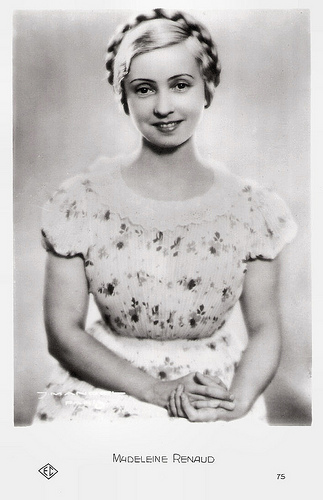
French postcard by EC, no. 75. Photo: J. Manuel, Paris.
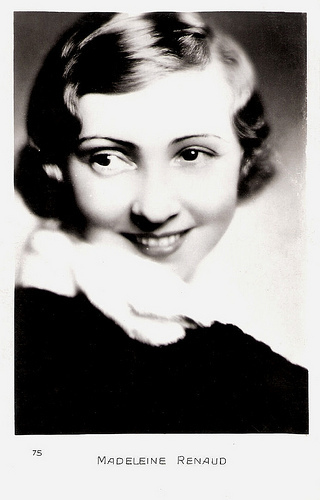
Vintage postcard, no. 75.
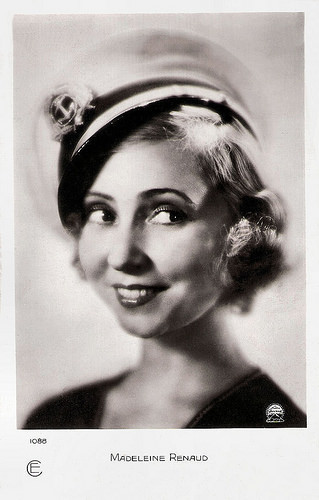
French postcard by CE (Cinémagazine-Édition), Paris, no. 1085. Photo: Paramount.
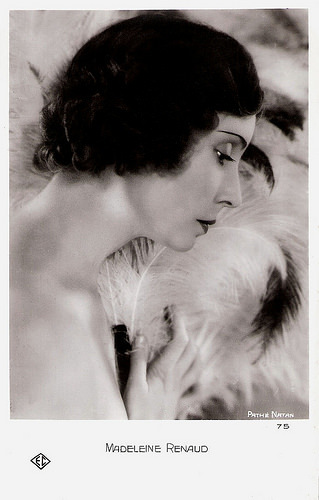
French postcard by EC, no. 75. Photo: Pathé Natan.
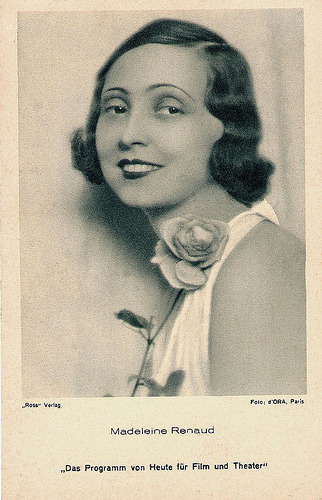
German postcard by Ross Verlag / Das Programm von Heute für Film und Theater. Photo: d'Ora. Paris.
Allure and Liveliness
Lucie Madeleine Renaud was born in 1900 as the daughter of a university professor, in the elegant seizieme arrondissement of Paris. She attended the Conservatoire Nationale d'Art Dramatique, having previously studied at the Lycee Racine, where she won first prize for comedy and obtained her baccalaureate.
At age 21, she entered the prestigious Comédie-Française as a junior actress, shedding her bourgeois background and starting an independent career. She remained there under contract until 1947.
In his obituary for The Independent , John Calder wrote: "Madeleine Renaud was the last of the great school of French classical actresses. She was trained just after the First World War, and had the flexibility to perform in the grand manner the established French repertoire, from Racine to Giraudoux, while still being totally convincing in the different schools of international theatre that have emerged since 1950.
Her early career overlapped with the last years of Sarah Bernhardt 's and she was already a star in the 1920s - before Edwige Feuillère , Maria Casares, Suzanne Flon and Arletty dominated the boards in Paris. By the time her juniors by a decade Michèle Morgan and Simone Signoret emerged, Renaud had established herself as one of the finest French actresses."
She incidentally played parts in silent films, such as the female leads in the films Vent debout/Midship (René Leprince, 1923) with Léon Mathot, and La terre qui meurt/The Land That Dies (Jean Choux, 1926), but her film performances intensified when sound cinema came along. She became an active and popular film actress of the 1930s.
Her first sound film was Jean de la Lune/Moon-Struck Jean (Jean Choux, 1930). This was an adaptation of a stage play by Marcel Achard, in which Renaud played with René Lefèvre and Michel Simon . During the 1930s Renaud played in some twenty films, often adaptations of novels and stage plays, contributing with her allure and liveliness.
One of her best known parts was the lead in the endearing film La Maternelle/Children of Montmartre (Jean-Benoit Lévy, Marie Epstein, 1933), a good example of French social realism of the 1930s. Renaud played Rose, a girl who becomes world wise when her father goes bankrupt and dies, and her lover dumps her. Rose becomes the caring maid in a Montmartre kindergarten and is soon the darling of the children, especially a prostitute’s daughter named Marie (Paulette Elambert), whose mother has dumped her as well. Marie, though, becomes jealous of other people caring about Rose.
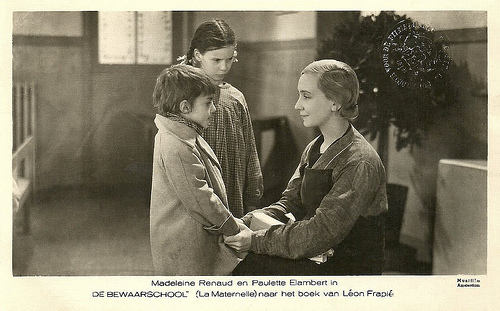
Dutch postcard by M.B.&Z. (M. Bonnist & Zonen). Photo: Muntfilm, Amsterdam. Publicity still for La Maternelle (1933). The card bears the stamp of the Dutch National Board of Film Censors.
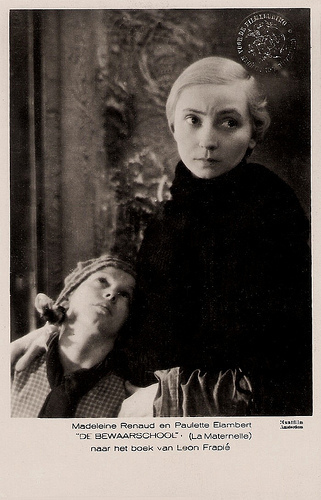
Dutch postcard by M.B.&Z. (M. Bonnist & Zonen). Photo: Muntfilm, Amsterdam.Publicity still for La Maternelle (1933).
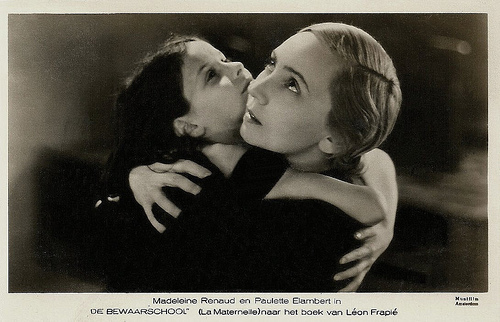
Dutch postcard by M.B.&Z. (M. Bonnist & Zonen). Photo: Muntfilm, Amsterdam. Publicity still for La Maternelle (1933). The card bears the stamp of the Dutch National Board of Film Censors.
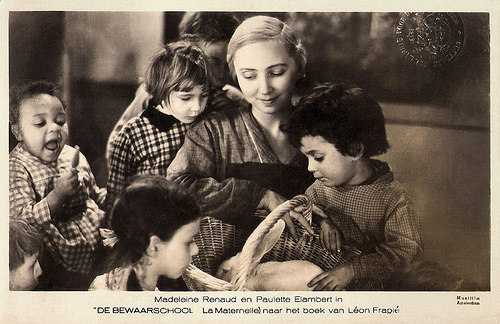
Dutch postcard by M.B.&Z., no. 75. Photo: Muntfilm, Amsterdam. Publicity still for La Maternelle/Children of Montmartre (Jean Benoît-Lévy, Marie Epstein, 1933).
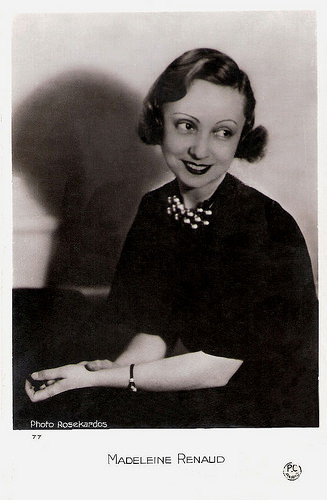
French postcard by Editions PC, Paris, no. 77. Photo: Rosekardos.
Fighting Elements and Suitors
Other memorable film titles of the 1930s in which Madeleine Renaud played leads were Le tunnel/The Tunnel (Curtis Bernhardt, 1933) with Jean Gabin working on a tunnel between the US and Europe (!); Maria Chapdelaine (Julien Duvivier, 1934) with Renaud as a young woman fighting both the elements and suitors in Canada.
She starred in the French-Italian comedy La marche nuptiale/The Wedding march (Mario Bonnard, 1935) after Henry Bataille’s play. Renaud played the role performed earlier by silent stars like Lyda Borelli ; and the multilingual Cœur de gueux/Cuore di vagabondo/A Beggar's Heart (Jean Epstein, 1936) with Italian stage veteran Ermete Zacconi .
From the late 1930s on, Renaud played less in film and almost exclusively under the direction of Jean Grémillon. She was the understanding wife of Raimu in L’étrange Monsieur Victor/The Odd Mr. Victor (Jean Grémillon, 1938), the abandoned and murdered wife of Jean Gabin in Remorques/Stormy Waters (Jean Grémillon, 1941), the perverse companion in Lumière d’été/Summer light (Jean Grémillon, 1943), and the aviation struck petite bourgeoise in Le ciel est à vous/The Woman Who Dared (Jean Grémillon, 1944).
After the war she concentrated on theatre, though she occasionally returned for roles as the savoury Mme Tellier in Le plaisir/House of Pleasure (Max Ophüls, 1952) based on three stories by Guy de Maupassant, and the malicious noblewoman in Le diable par la queue/The Devil by the Tail (Philippe de Broca, 1969) opposite Yves Montand .
Along with several other noted French actors, Madeleine Renaud appeared in a cameo role in the mammoth, all-star re-creation of the D-Day invasion, The Longest Day (Ken Annakin, Andrew Marton, Bernhard Wicki, 1962), playing a fearless Mother Superior. One of her final film roles was the possessive mother of Jean-Pierre Aumont in Des journées entières dans les arbres/Entire Days Among the Trees (Marguerite Duras, 1976).
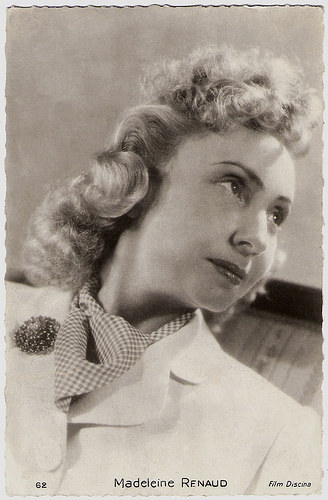
French postcard by Editions E.C., Paris, no. 62. Photo: Film Discina.
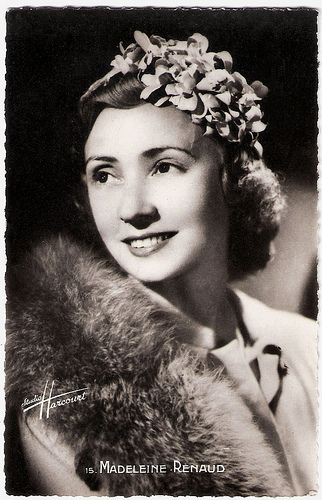
French postcard by SERP, Paris, no. 15. Photo: Studio Harcourt.
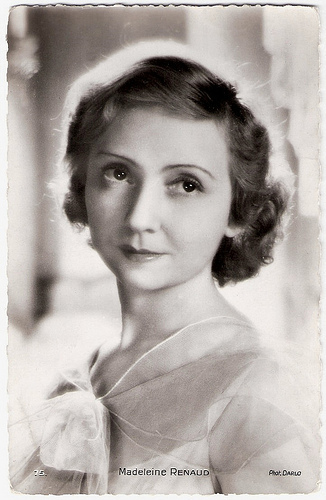
French postcard by Ed. Chantal, Paris, no. 75. Photo: Darlo.
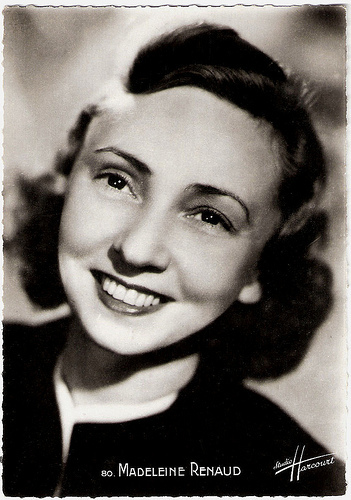
French postcard by S.E.R.P., Paris, no. 80. Photo: Studio Harcourt.
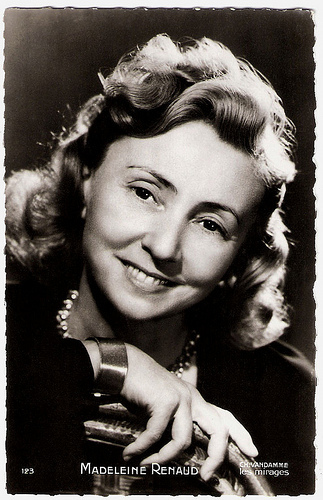
French postcard by Editions P.I.., Paris, offered by Les Carbones Korès Carboplane, no. 123. Photo: Charles Vandamme / Les Mirages.
Jean-Louis Barrault
In 1936 Madeleine Renaud had met her future husband, actor and director Jean-Louis Barrault , a brilliant young actor from a working-class background, full of new theatrical ideas and aflame with ambition. In 1940, he joined the Comédie-Francaise and in a very short time he was playing major roles and directing productions. They fell in love and married the same year.
In 1943 the couple worked together in raising the play Soulier de satin (Satin Shoe) by Paul Claudel, directed by Barrault. After having played 127 parts at the Comédie-Française, Renaud left the company in 1946 to form her own company with Barrault, which was based at the Théâtre Marigny.
There she created the part of Winnie in Oh! Les beaux jours (Happy Days) by Samuel Beckett in 1963; it was a part she would continue to perform until the end of her career. Renaud also played in plays by Jean Genet, Marguerite Duras, and Eugène Ionesco.
In the mean time, her husband Barrault rose to the position of managing director of the Théâtre de l'Odéon-Théâtre de France. After the student revolt of 1968, Barrault, having shown sympathy for the students was evicted from the Odéon by President de Gaulle. The company rented an old skating rink and continued to perform there, mainly in the round, improvising and making virtues out of necessity. The public supported the new theatre massively.
For a while Madeleine Renaud went away from the company to play next to Claude Régy in L'Amante anglaise (The English Lover) by Marguerite Duras. Afterwards she played Maud in Harold et Maud (Harold and Maude) written by Colin Higgins, a role to which she stuck for a long time, also when the company moved to the Musée d'Orsay, and afterwards to the Théâtre du Rond-Point.
Incidentally their plays were filmed for TV. In 1978, Jean-Paul Carrère directed his own script for a TV version of Harold et Maud/Harold and Maude, and a TV-film was also made of Oh! Les beaux jours/Happy Days (Alexandre Tarta, 1990) starring Renaud and Barrault in their acclaimed roles of Winnie and Willy. It was her last 'film' role.
Madeleine Renaud died in Paris in 1994, seven months after the decease of her husband. She was married three times, to director Charles Gribouval (Charles Grandval), secondly to actor Pierre Bertin (some sources say she was only 'romantically involved' with him), and thirdly to Jean-Louis Barrault. She had a son, Jean-Pierre Granval (1923-1998), by her first marriage, and she was the aunt of actress Marie-Christine Barrault. Madeleine Renaud received many honours, was a Commander of the Legion of Honour, a Grand Officer of the Order of Arts and Letters and was awarded the Medal of the City of Paris and the Grand Prix du Theatre.
Long scene from La Maternelle/Children of Montmartre (1933). Source: Lost Classic Films (YouTube).
Scene from Le Plaisir (1952). Source: luc lebelgo26 (YouTube).
Trailer of The Longest Day (1962). Source: Humanoidity (YouTube).
Sources: Hal Erickson (AllMovie), John Calder (The Independent), Ciné-Ressources (French), Wikipedia (French), and .

French postcard by EC, no. 75. Photo: J. Manuel, Paris.

Vintage postcard, no. 75.

French postcard by CE (Cinémagazine-Édition), Paris, no. 1085. Photo: Paramount.

French postcard by EC, no. 75. Photo: Pathé Natan.

German postcard by Ross Verlag / Das Programm von Heute für Film und Theater. Photo: d'Ora. Paris.
Allure and Liveliness
Lucie Madeleine Renaud was born in 1900 as the daughter of a university professor, in the elegant seizieme arrondissement of Paris. She attended the Conservatoire Nationale d'Art Dramatique, having previously studied at the Lycee Racine, where she won first prize for comedy and obtained her baccalaureate.
At age 21, she entered the prestigious Comédie-Française as a junior actress, shedding her bourgeois background and starting an independent career. She remained there under contract until 1947.
In his obituary for The Independent , John Calder wrote: "Madeleine Renaud was the last of the great school of French classical actresses. She was trained just after the First World War, and had the flexibility to perform in the grand manner the established French repertoire, from Racine to Giraudoux, while still being totally convincing in the different schools of international theatre that have emerged since 1950.
Her early career overlapped with the last years of Sarah Bernhardt 's and she was already a star in the 1920s - before Edwige Feuillère , Maria Casares, Suzanne Flon and Arletty dominated the boards in Paris. By the time her juniors by a decade Michèle Morgan and Simone Signoret emerged, Renaud had established herself as one of the finest French actresses."
She incidentally played parts in silent films, such as the female leads in the films Vent debout/Midship (René Leprince, 1923) with Léon Mathot, and La terre qui meurt/The Land That Dies (Jean Choux, 1926), but her film performances intensified when sound cinema came along. She became an active and popular film actress of the 1930s.
Her first sound film was Jean de la Lune/Moon-Struck Jean (Jean Choux, 1930). This was an adaptation of a stage play by Marcel Achard, in which Renaud played with René Lefèvre and Michel Simon . During the 1930s Renaud played in some twenty films, often adaptations of novels and stage plays, contributing with her allure and liveliness.
One of her best known parts was the lead in the endearing film La Maternelle/Children of Montmartre (Jean-Benoit Lévy, Marie Epstein, 1933), a good example of French social realism of the 1930s. Renaud played Rose, a girl who becomes world wise when her father goes bankrupt and dies, and her lover dumps her. Rose becomes the caring maid in a Montmartre kindergarten and is soon the darling of the children, especially a prostitute’s daughter named Marie (Paulette Elambert), whose mother has dumped her as well. Marie, though, becomes jealous of other people caring about Rose.

Dutch postcard by M.B.&Z. (M. Bonnist & Zonen). Photo: Muntfilm, Amsterdam. Publicity still for La Maternelle (1933). The card bears the stamp of the Dutch National Board of Film Censors.

Dutch postcard by M.B.&Z. (M. Bonnist & Zonen). Photo: Muntfilm, Amsterdam.Publicity still for La Maternelle (1933).

Dutch postcard by M.B.&Z. (M. Bonnist & Zonen). Photo: Muntfilm, Amsterdam. Publicity still for La Maternelle (1933). The card bears the stamp of the Dutch National Board of Film Censors.

Dutch postcard by M.B.&Z., no. 75. Photo: Muntfilm, Amsterdam. Publicity still for La Maternelle/Children of Montmartre (Jean Benoît-Lévy, Marie Epstein, 1933).

French postcard by Editions PC, Paris, no. 77. Photo: Rosekardos.
Fighting Elements and Suitors
Other memorable film titles of the 1930s in which Madeleine Renaud played leads were Le tunnel/The Tunnel (Curtis Bernhardt, 1933) with Jean Gabin working on a tunnel between the US and Europe (!); Maria Chapdelaine (Julien Duvivier, 1934) with Renaud as a young woman fighting both the elements and suitors in Canada.
She starred in the French-Italian comedy La marche nuptiale/The Wedding march (Mario Bonnard, 1935) after Henry Bataille’s play. Renaud played the role performed earlier by silent stars like Lyda Borelli ; and the multilingual Cœur de gueux/Cuore di vagabondo/A Beggar's Heart (Jean Epstein, 1936) with Italian stage veteran Ermete Zacconi .
From the late 1930s on, Renaud played less in film and almost exclusively under the direction of Jean Grémillon. She was the understanding wife of Raimu in L’étrange Monsieur Victor/The Odd Mr. Victor (Jean Grémillon, 1938), the abandoned and murdered wife of Jean Gabin in Remorques/Stormy Waters (Jean Grémillon, 1941), the perverse companion in Lumière d’été/Summer light (Jean Grémillon, 1943), and the aviation struck petite bourgeoise in Le ciel est à vous/The Woman Who Dared (Jean Grémillon, 1944).
After the war she concentrated on theatre, though she occasionally returned for roles as the savoury Mme Tellier in Le plaisir/House of Pleasure (Max Ophüls, 1952) based on three stories by Guy de Maupassant, and the malicious noblewoman in Le diable par la queue/The Devil by the Tail (Philippe de Broca, 1969) opposite Yves Montand .
Along with several other noted French actors, Madeleine Renaud appeared in a cameo role in the mammoth, all-star re-creation of the D-Day invasion, The Longest Day (Ken Annakin, Andrew Marton, Bernhard Wicki, 1962), playing a fearless Mother Superior. One of her final film roles was the possessive mother of Jean-Pierre Aumont in Des journées entières dans les arbres/Entire Days Among the Trees (Marguerite Duras, 1976).

French postcard by Editions E.C., Paris, no. 62. Photo: Film Discina.

French postcard by SERP, Paris, no. 15. Photo: Studio Harcourt.

French postcard by Ed. Chantal, Paris, no. 75. Photo: Darlo.

French postcard by S.E.R.P., Paris, no. 80. Photo: Studio Harcourt.

French postcard by Editions P.I.., Paris, offered by Les Carbones Korès Carboplane, no. 123. Photo: Charles Vandamme / Les Mirages.
Jean-Louis Barrault
In 1936 Madeleine Renaud had met her future husband, actor and director Jean-Louis Barrault , a brilliant young actor from a working-class background, full of new theatrical ideas and aflame with ambition. In 1940, he joined the Comédie-Francaise and in a very short time he was playing major roles and directing productions. They fell in love and married the same year.
In 1943 the couple worked together in raising the play Soulier de satin (Satin Shoe) by Paul Claudel, directed by Barrault. After having played 127 parts at the Comédie-Française, Renaud left the company in 1946 to form her own company with Barrault, which was based at the Théâtre Marigny.
There she created the part of Winnie in Oh! Les beaux jours (Happy Days) by Samuel Beckett in 1963; it was a part she would continue to perform until the end of her career. Renaud also played in plays by Jean Genet, Marguerite Duras, and Eugène Ionesco.
In the mean time, her husband Barrault rose to the position of managing director of the Théâtre de l'Odéon-Théâtre de France. After the student revolt of 1968, Barrault, having shown sympathy for the students was evicted from the Odéon by President de Gaulle. The company rented an old skating rink and continued to perform there, mainly in the round, improvising and making virtues out of necessity. The public supported the new theatre massively.
For a while Madeleine Renaud went away from the company to play next to Claude Régy in L'Amante anglaise (The English Lover) by Marguerite Duras. Afterwards she played Maud in Harold et Maud (Harold and Maude) written by Colin Higgins, a role to which she stuck for a long time, also when the company moved to the Musée d'Orsay, and afterwards to the Théâtre du Rond-Point.
Incidentally their plays were filmed for TV. In 1978, Jean-Paul Carrère directed his own script for a TV version of Harold et Maud/Harold and Maude, and a TV-film was also made of Oh! Les beaux jours/Happy Days (Alexandre Tarta, 1990) starring Renaud and Barrault in their acclaimed roles of Winnie and Willy. It was her last 'film' role.
Madeleine Renaud died in Paris in 1994, seven months after the decease of her husband. She was married three times, to director Charles Gribouval (Charles Grandval), secondly to actor Pierre Bertin (some sources say she was only 'romantically involved' with him), and thirdly to Jean-Louis Barrault. She had a son, Jean-Pierre Granval (1923-1998), by her first marriage, and she was the aunt of actress Marie-Christine Barrault. Madeleine Renaud received many honours, was a Commander of the Legion of Honour, a Grand Officer of the Order of Arts and Letters and was awarded the Medal of the City of Paris and the Grand Prix du Theatre.
Long scene from La Maternelle/Children of Montmartre (1933). Source: Lost Classic Films (YouTube).
Scene from Le Plaisir (1952). Source: luc lebelgo26 (YouTube).
Trailer of The Longest Day (1962). Source: Humanoidity (YouTube).
Sources: Hal Erickson (AllMovie), John Calder (The Independent), Ciné-Ressources (French), Wikipedia (French), and .
Published on April 22, 2016 22:00
April 21, 2016
Goldfinger (1964)
Film director Guy Hamilton, born 16 September 1922; died 20 April 2016. He was one of Britain’s most bankable film-makers with four James Bond films – Goldfinger (1964), Diamonds Are Forever (1971), Live and Let Die (1973) and The Man With the Golden Gun (1974) – among his credits. Today a post on our favourite. Goldfinger is the quintessential episode in the James Bond series, filled with thrills, girls and danger. It was the third episode and the third to star suave and ultra-cool Sean Connery as agent 007. Everything seemed to be right, the stunts, the sets, the score, the gadgets, and a wonderful cast. The film co-stars Honor Blackman as Pussy Galore, Gert Fröbe as Auric Goldfinger, and Shirley Eaton as the iconic Bond girl Jill Masterson.
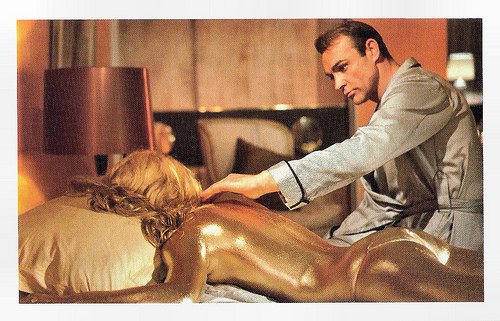
British postcard by Danjaq, LLC and United Artists Corporation. Photo: publicity still for Goldfinger (Guy Hamilton, 1964). Caption: James Bond ( Sean Connery ) discovers Jill Masterson ( Shirley Eaton ) dead and covered in gold paint in Goldfinger (1964).
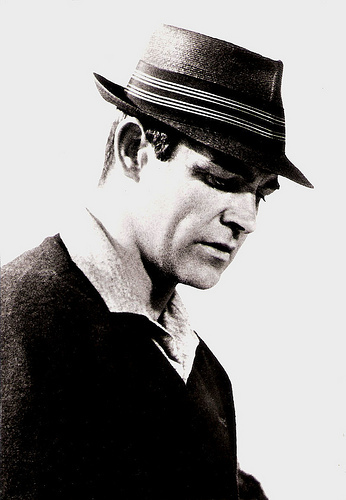
Dutch card, no. AX 6263. Publicity still for Goldfinger (Guy Hamilton, 1964).
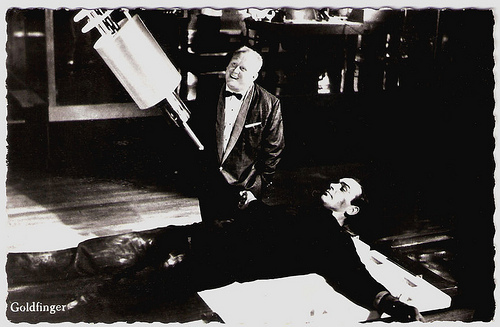
Dutch postcard. Sent by mail in 1966. Publicity still for Goldfinger (1964) with Sean Connery and Gert Fröbe. "Do you expect me to talk, Goldfinger?" Bond asks as the laser beam slowly makes its way towards his groin. "No, Mr. Bond, I expect you to die!" Goldfinger answers.
Not inside Fort Knox
Goldfinger was based again on a novel by Ian Fleming. There isn't much of a plot, really. James Bond is investigating gold smuggling by gold magnate Auric Goldfinger and eventually uncovering Goldfinger's plans to contaminate the Fort Knox gold reserve.
Producers were Albert R. Broccoli and Harry Saltzman. Goldfinger had what was then considered a large budget of $3 million (US$22,812,232 in 2015 dollars), the equivalent of the budgets of Dr. No (Terence Young, 1962) and From Russia with Love (Terence Young, 1963) combined, and was the first James Bond film classified as a box-office blockbuster.
Goldfinger saw the return of two crew members who were not involved with From Russia With Love: stunt coordinator Bob Simmons and production designer Ken Adam. Both played crucial roles in the development of Goldfinger. Simmons choreographed the fight sequence between Bond and Oddjob (Harold Sakata) in the vault of Fort Knox, one of the best Bond fights.
For security reasons, the filmmakers were not allowed to film inside Fort Knox, although exterior photography was permitted. All sets for the interiors were designed and built from scratch at Pinewood Studios. The filmmakers had no clue as to what the interior of the depository looked like, so Ken Adam's imagination provided the idea of gold stacked upon gold behind iron bars. Harry Saltzman disliked the design's resemblance to a prison, but Guy Hamilton liked it enough that it was built. The comptroller of Fort Knox later sent a letter to Adam and the production team, complimenting them on their imaginative depiction of the vault.
Principal photography took place from January to July 1964 in the United Kingdom, Switzerland and the U.S. states of Kentucky and Florida. The opening credit sequence was designed by graphic artist Robert Brownjohn, featuring clips of all James Bond films thus far projected on actress Margaret Nolan's body. Its design was inspired by seeing light projecting on people's bodies as they got up and left a cinema. Brownjohn was also responsible for the posters for the advertising campaign, which also used Nolan.
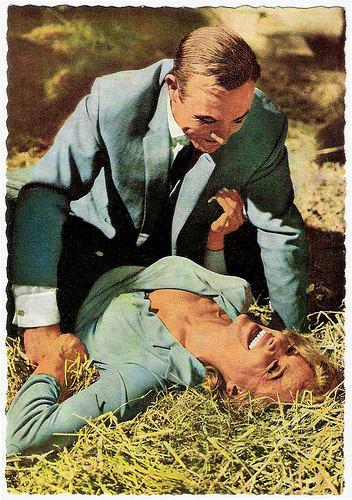
German postcard. Photo: P.A. Reuter. Publicity still for Goldfinger (Guy Hamilton, 1964) with Sean Connery and Honor Blackman .
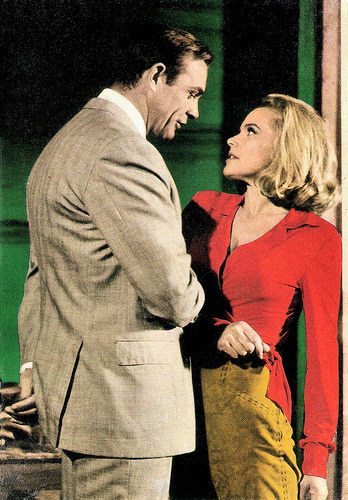
Spanish postcard by Postal Oscarcolor, no. 355. Photo: publicity still for Goldfinger (Guy Hamilton, 1964) with Sean Connery and Honor Blackman .
Pussy Galore
Honor Blackman played Pussy Galore, Goldfinger's personal pilot and leader of an all-female team of pilots known as Pussy Galore's Flying Circus. Blackman was selected for the role of Pussy Galore because of her role as Cathy Gale in the classic British TV series The Avengers (1962-1964) and the script was rewritten to show Blackman's judo abilities. The character's name follows in the tradition of other Bond girls names that are double entendres. During promotion, Blackman took delight in embarrassing interviewers by repeatedly mentioning the character's name.
Gert Fröbe was excellent as Bond villain Auric Goldfinger, the 'international cheat, international menace' obsessed with gold. Orson Welles was considered as Goldfinger, but his financial demands were too high. Fröbe was cast because the producers saw his performance as a child molester in the German film Es geschah am hellichten Tag/It Happened in Broad Daylight (Ladislao Vajda, 1958). Fröbe, who spoke little English, said his lines phonetically.
British actress Shirley Eaton played Jill Masterson, Bond Girl and Goldfinger's aide-de-camp. Bond catches her helping the villain cheat at a game of cards. He seduces her, but for her betrayal, she is completely painted in gold paint and dies from "skin suffocation". Although only a small part in the film, the image of her painted gold was renowned and Eaton graced the cover of Life magazine of 6 November 1964.
And Goldfinger was also the first of the Bond films to feature Q (Desmond Llewelyn). In From Russia with Love (Terence Young, 1963) Llewelyn had played the role of Major Boothroyd. Q became the beloved comic relief figure of the series and Llewellyn appeared in 17 James Bond films until his death in 1999. He was absent in Live and Let Die (Guy Hamilton, 1973), because producers felt too much attention was being paid on the gadgetry so they downplayed it by cutting his role. However, audiences enjoyed Q so much that Llewelyn was brought back indefinitely.
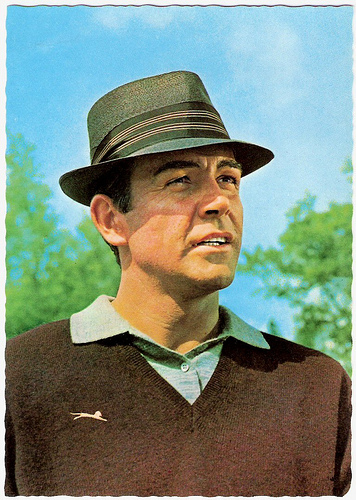
German postcard by ISV, no. H 119. Publicity still for Goldfinger (Guy Hamilton, 1964).
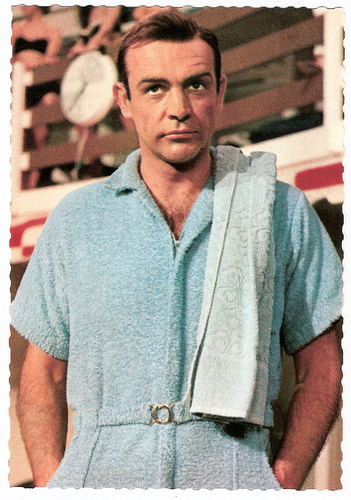
German postcard by ISV, no. H 123. Publicity still for Goldfinger (Guy Hamilton, 1964).
Goldfinger began to up the ante
Shirley Bassey sang the theme song Goldfinger, and she would go on to sing the theme songs for two other Bond films, Diamonds are Forever (Guy Hamilton, 1971) and Moonraker (Lewis Gilbert, 1979). The song was composed by John Barry, with lyrics by Anthony Newley and Leslie Bricusse.
Goldfinger was the first of the series to feature the famous line, "Bond, James Bond," as a 007 catchphrase. It also featured the most famous James Bond car, the 1964 silver birch Aston Martin DB5, was introduced in Goldfinger. To promote the film, the two Aston Martin DB5s were showcased at the 1964 New York World's Fair. It was dubbed 'the most famous car in the world', and sales of the car rose.
Corgi Toys began a decades-long relationship with the Bond franchise, producing a toy of the car, which became the biggest selling toy of 1964. The film's success also led to licensed tie-in clothing, dress shoes, action figures, board games, jigsaw puzzles, lunch boxes, toys, record albums, slot cars, and postcards.
Lucia Bozzola at AllMovie : "Goldfinger set the gold standard (naturally) for future James Bond adventures. With the films' signature elements firmly entrenched - including globe-trotting story, salacious credits sequence, Q's exasperation, and 007's phenomenal abilities with women and antagonists - Goldfinger began to up the ante. Bond's well-equipped Aston-Martin and Goldfinger's elaborate Fort Knox model presaged future technical extravagance, while Bond's near castration via a giant laser was one more sign of the series' humorous self-awareness."
Goldfinger became the first Bond film to win an Academy Award. At the 1965 Academy Awards, Norman Wanstall won the Academy Award for Best Sound Effects Editing for his work. Ken Adam was nominated for the British Academy of Film and Television Arts (BAFTA) for Best British Art Direction (Colour). The film opened to largely favourable critical reception and was a financial success. Goldfinger 's $3 million budget was recouped in two weeks, and it broke box office records in multiple countries around the world.
Official trailer Goldfinger (1964). Source: MoviesHistory (YouTube).
The title sequence by Robert Brownjohn. Source: juanmurs (YouTube).
Sources: Lucia Bozzola (AllMovie), Wikipedia and IMDb.
This is a post for Postcard Friendship Friday, hosted by Beth at the The Best Hearts are Crunchy. You can visit her by clicking on the button below.


British postcard by Danjaq, LLC and United Artists Corporation. Photo: publicity still for Goldfinger (Guy Hamilton, 1964). Caption: James Bond ( Sean Connery ) discovers Jill Masterson ( Shirley Eaton ) dead and covered in gold paint in Goldfinger (1964).

Dutch card, no. AX 6263. Publicity still for Goldfinger (Guy Hamilton, 1964).

Dutch postcard. Sent by mail in 1966. Publicity still for Goldfinger (1964) with Sean Connery and Gert Fröbe. "Do you expect me to talk, Goldfinger?" Bond asks as the laser beam slowly makes its way towards his groin. "No, Mr. Bond, I expect you to die!" Goldfinger answers.
Not inside Fort Knox
Goldfinger was based again on a novel by Ian Fleming. There isn't much of a plot, really. James Bond is investigating gold smuggling by gold magnate Auric Goldfinger and eventually uncovering Goldfinger's plans to contaminate the Fort Knox gold reserve.
Producers were Albert R. Broccoli and Harry Saltzman. Goldfinger had what was then considered a large budget of $3 million (US$22,812,232 in 2015 dollars), the equivalent of the budgets of Dr. No (Terence Young, 1962) and From Russia with Love (Terence Young, 1963) combined, and was the first James Bond film classified as a box-office blockbuster.
Goldfinger saw the return of two crew members who were not involved with From Russia With Love: stunt coordinator Bob Simmons and production designer Ken Adam. Both played crucial roles in the development of Goldfinger. Simmons choreographed the fight sequence between Bond and Oddjob (Harold Sakata) in the vault of Fort Knox, one of the best Bond fights.
For security reasons, the filmmakers were not allowed to film inside Fort Knox, although exterior photography was permitted. All sets for the interiors were designed and built from scratch at Pinewood Studios. The filmmakers had no clue as to what the interior of the depository looked like, so Ken Adam's imagination provided the idea of gold stacked upon gold behind iron bars. Harry Saltzman disliked the design's resemblance to a prison, but Guy Hamilton liked it enough that it was built. The comptroller of Fort Knox later sent a letter to Adam and the production team, complimenting them on their imaginative depiction of the vault.
Principal photography took place from January to July 1964 in the United Kingdom, Switzerland and the U.S. states of Kentucky and Florida. The opening credit sequence was designed by graphic artist Robert Brownjohn, featuring clips of all James Bond films thus far projected on actress Margaret Nolan's body. Its design was inspired by seeing light projecting on people's bodies as they got up and left a cinema. Brownjohn was also responsible for the posters for the advertising campaign, which also used Nolan.

German postcard. Photo: P.A. Reuter. Publicity still for Goldfinger (Guy Hamilton, 1964) with Sean Connery and Honor Blackman .

Spanish postcard by Postal Oscarcolor, no. 355. Photo: publicity still for Goldfinger (Guy Hamilton, 1964) with Sean Connery and Honor Blackman .
Pussy Galore
Honor Blackman played Pussy Galore, Goldfinger's personal pilot and leader of an all-female team of pilots known as Pussy Galore's Flying Circus. Blackman was selected for the role of Pussy Galore because of her role as Cathy Gale in the classic British TV series The Avengers (1962-1964) and the script was rewritten to show Blackman's judo abilities. The character's name follows in the tradition of other Bond girls names that are double entendres. During promotion, Blackman took delight in embarrassing interviewers by repeatedly mentioning the character's name.
Gert Fröbe was excellent as Bond villain Auric Goldfinger, the 'international cheat, international menace' obsessed with gold. Orson Welles was considered as Goldfinger, but his financial demands were too high. Fröbe was cast because the producers saw his performance as a child molester in the German film Es geschah am hellichten Tag/It Happened in Broad Daylight (Ladislao Vajda, 1958). Fröbe, who spoke little English, said his lines phonetically.
British actress Shirley Eaton played Jill Masterson, Bond Girl and Goldfinger's aide-de-camp. Bond catches her helping the villain cheat at a game of cards. He seduces her, but for her betrayal, she is completely painted in gold paint and dies from "skin suffocation". Although only a small part in the film, the image of her painted gold was renowned and Eaton graced the cover of Life magazine of 6 November 1964.
And Goldfinger was also the first of the Bond films to feature Q (Desmond Llewelyn). In From Russia with Love (Terence Young, 1963) Llewelyn had played the role of Major Boothroyd. Q became the beloved comic relief figure of the series and Llewellyn appeared in 17 James Bond films until his death in 1999. He was absent in Live and Let Die (Guy Hamilton, 1973), because producers felt too much attention was being paid on the gadgetry so they downplayed it by cutting his role. However, audiences enjoyed Q so much that Llewelyn was brought back indefinitely.

German postcard by ISV, no. H 119. Publicity still for Goldfinger (Guy Hamilton, 1964).

German postcard by ISV, no. H 123. Publicity still for Goldfinger (Guy Hamilton, 1964).
Goldfinger began to up the ante
Shirley Bassey sang the theme song Goldfinger, and she would go on to sing the theme songs for two other Bond films, Diamonds are Forever (Guy Hamilton, 1971) and Moonraker (Lewis Gilbert, 1979). The song was composed by John Barry, with lyrics by Anthony Newley and Leslie Bricusse.
Goldfinger was the first of the series to feature the famous line, "Bond, James Bond," as a 007 catchphrase. It also featured the most famous James Bond car, the 1964 silver birch Aston Martin DB5, was introduced in Goldfinger. To promote the film, the two Aston Martin DB5s were showcased at the 1964 New York World's Fair. It was dubbed 'the most famous car in the world', and sales of the car rose.
Corgi Toys began a decades-long relationship with the Bond franchise, producing a toy of the car, which became the biggest selling toy of 1964. The film's success also led to licensed tie-in clothing, dress shoes, action figures, board games, jigsaw puzzles, lunch boxes, toys, record albums, slot cars, and postcards.
Lucia Bozzola at AllMovie : "Goldfinger set the gold standard (naturally) for future James Bond adventures. With the films' signature elements firmly entrenched - including globe-trotting story, salacious credits sequence, Q's exasperation, and 007's phenomenal abilities with women and antagonists - Goldfinger began to up the ante. Bond's well-equipped Aston-Martin and Goldfinger's elaborate Fort Knox model presaged future technical extravagance, while Bond's near castration via a giant laser was one more sign of the series' humorous self-awareness."
Goldfinger became the first Bond film to win an Academy Award. At the 1965 Academy Awards, Norman Wanstall won the Academy Award for Best Sound Effects Editing for his work. Ken Adam was nominated for the British Academy of Film and Television Arts (BAFTA) for Best British Art Direction (Colour). The film opened to largely favourable critical reception and was a financial success. Goldfinger 's $3 million budget was recouped in two weeks, and it broke box office records in multiple countries around the world.
Official trailer Goldfinger (1964). Source: MoviesHistory (YouTube).
The title sequence by Robert Brownjohn. Source: juanmurs (YouTube).
Sources: Lucia Bozzola (AllMovie), Wikipedia and IMDb.
This is a post for Postcard Friendship Friday, hosted by Beth at the The Best Hearts are Crunchy. You can visit her by clicking on the button below.

Published on April 21, 2016 22:00
April 20, 2016
La piccola vedetta lombarda (1915)
La piccola vedetta lombarda/The Little Lookout from Lombardy is one of the stories from Edmondo De Amicis's 1886 book Cuore (Heart), which were adapted to film by the Italian production company Film Artistica Gloria in 1915 and 1916. Director was Vittorio Rossi-Pianelli who was more famous as an actor. The main actors in the film were Luigino (Luigi) Petrungaro as the boy, and Antonio Monti as the officer.
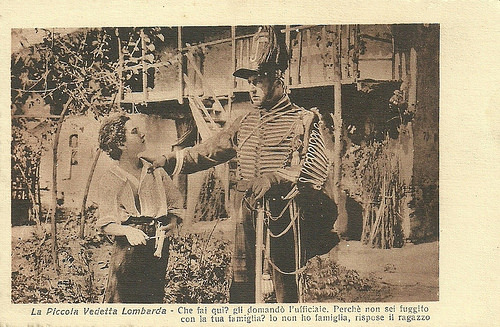
Italian postcard. Photo: publicity still for La piccola vedetta lombarda/The Little Lookout from Lombardy (1915). Caption: What are you doing here? the officer asked. Why didn't you flee with your family? I don't have family, the boy answered.
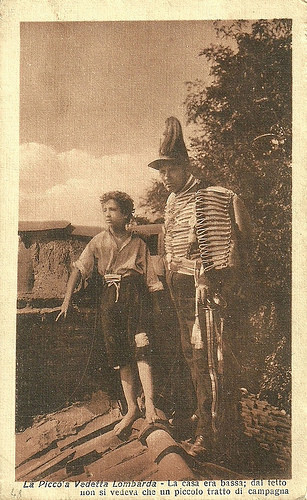
Italian postcard. Photo: publicity still for La piccola vedetta lombarda/The Little Lookout from Lombardy (1915). Caption: The house was very low; from the roof you could only see a little part of the countryside.
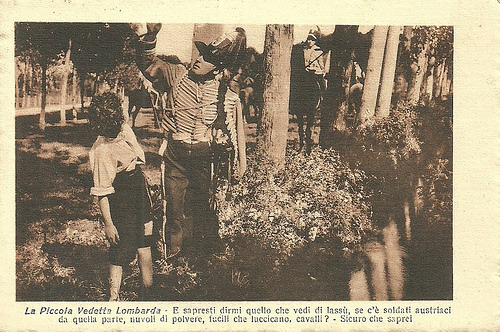
Italian postcard. Photo: publicity still for La piccola vedetta lombarda/The Little Lookout from Lombardy (1915). Caption: And can you tell me what you can see from above there, if there are Austrian soldiers there, clouds of dust, rifles that light up, horses? Sure I can.
The Little Lookout
The story of La piccola vedetta lombarda/The Little Lookout from Lombardy takes place during the Risorgimento, after the battle of Solferino in 1859. Italian soldiers ask an orphan boy from Lombardy (Luigino Petrangaro) to spy on the Austrian enemy troops. First he climbs on a roof and when that is too low, he spies from a high tree.
Despite the officer (Antonio Monti) asking him to come down, the boy stays too long in the tree and he is shot down by enemy fire. The soldiers pay their respects to his patriotic death, each passing his corps draped in the flag to honor him. And there he slept in the grass, draped in his flag, his face white, smiling, as if he was happy to have given his life for Lombardy, reads the caption of the postcard below.
A year after his role in this film, little Luigino Petrangaro starred in another Gloria production based on a story from Cuore (Heart), Sangue Romagnolo/Blood from the Romagna (Leopoldo Carlucci, 1916).
Gloria adapted several stories from Edmondo De Amicis' popular book Cuore about the life of nine boys in a school class in the city of Turin. Earlier, we did also a post on Dagli Appennini alle Ande/From the Apennines to the Andes (Umberto Paradisi, 1916).
For a long time the story of La piccola vedetta lombarda was considered as fiction. But author Edmondo de Amicis based in 1886 his story on a historical incident with the orphan Giovanni Minoli (1947-1859). In 2009 historians Fabrizio Bernini and Daniele Salerno have completed and published a meticulous reconstruction of the facts, based on archival documents of the time, which confirms the real existence of Giovanni Minoli and his tragic end.
There are some variations between fact and fiction. In the novel and the film, the boy dies almost immediately while in reality he died after a few months suffering in a hospital. The tree in which he climbed is in the story an ash tree while in reality it was a poplar. This poplar still exists.
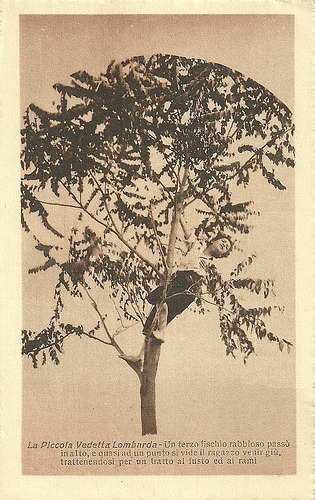
Italian postcard. Photo: publicity still for La piccola vedetta lombarda/The Little Lookout from Lombardy (1915). Caption: A rabid, third whistle passed high up, and almost instantly one saw the boy falling down, holding on to the branches and the stem.
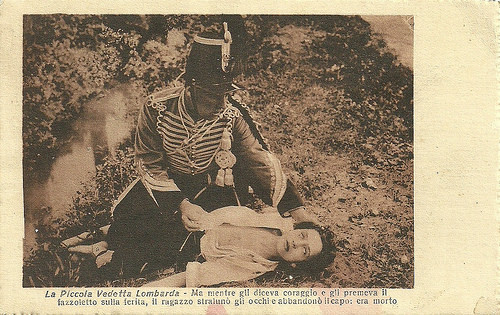
Italian postcard. Photo: publicity still for La piccola vedetta lombarda/The Little Look-out from Lombardy (1915). Caption: But while he told him to be brave and pressed a handkerchief on the wound, the boy's eyes broke and he bent his head: he was dead.
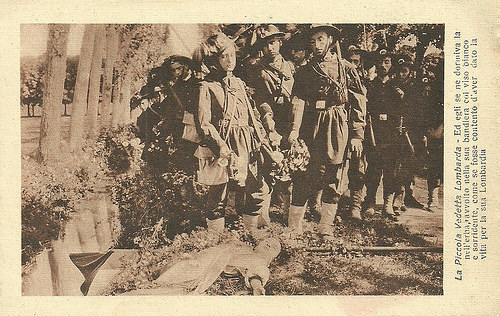
Italian postcard. Photo: publicity still for La piccola vedetta lombarda/The Little Lookout from Lombardy (1915). Caption: And there he slept in the grass, draped in his flag, his face white, smiling, as if he was happy to have given his life for Lombardy.
For the full film, see Vimeo. Sources: Vimeo, Wikipedia (Italian) and IMDb.

Italian postcard. Photo: publicity still for La piccola vedetta lombarda/The Little Lookout from Lombardy (1915). Caption: What are you doing here? the officer asked. Why didn't you flee with your family? I don't have family, the boy answered.

Italian postcard. Photo: publicity still for La piccola vedetta lombarda/The Little Lookout from Lombardy (1915). Caption: The house was very low; from the roof you could only see a little part of the countryside.

Italian postcard. Photo: publicity still for La piccola vedetta lombarda/The Little Lookout from Lombardy (1915). Caption: And can you tell me what you can see from above there, if there are Austrian soldiers there, clouds of dust, rifles that light up, horses? Sure I can.
The Little Lookout
The story of La piccola vedetta lombarda/The Little Lookout from Lombardy takes place during the Risorgimento, after the battle of Solferino in 1859. Italian soldiers ask an orphan boy from Lombardy (Luigino Petrangaro) to spy on the Austrian enemy troops. First he climbs on a roof and when that is too low, he spies from a high tree.
Despite the officer (Antonio Monti) asking him to come down, the boy stays too long in the tree and he is shot down by enemy fire. The soldiers pay their respects to his patriotic death, each passing his corps draped in the flag to honor him. And there he slept in the grass, draped in his flag, his face white, smiling, as if he was happy to have given his life for Lombardy, reads the caption of the postcard below.
A year after his role in this film, little Luigino Petrangaro starred in another Gloria production based on a story from Cuore (Heart), Sangue Romagnolo/Blood from the Romagna (Leopoldo Carlucci, 1916).
Gloria adapted several stories from Edmondo De Amicis' popular book Cuore about the life of nine boys in a school class in the city of Turin. Earlier, we did also a post on Dagli Appennini alle Ande/From the Apennines to the Andes (Umberto Paradisi, 1916).
For a long time the story of La piccola vedetta lombarda was considered as fiction. But author Edmondo de Amicis based in 1886 his story on a historical incident with the orphan Giovanni Minoli (1947-1859). In 2009 historians Fabrizio Bernini and Daniele Salerno have completed and published a meticulous reconstruction of the facts, based on archival documents of the time, which confirms the real existence of Giovanni Minoli and his tragic end.
There are some variations between fact and fiction. In the novel and the film, the boy dies almost immediately while in reality he died after a few months suffering in a hospital. The tree in which he climbed is in the story an ash tree while in reality it was a poplar. This poplar still exists.

Italian postcard. Photo: publicity still for La piccola vedetta lombarda/The Little Lookout from Lombardy (1915). Caption: A rabid, third whistle passed high up, and almost instantly one saw the boy falling down, holding on to the branches and the stem.

Italian postcard. Photo: publicity still for La piccola vedetta lombarda/The Little Look-out from Lombardy (1915). Caption: But while he told him to be brave and pressed a handkerchief on the wound, the boy's eyes broke and he bent his head: he was dead.

Italian postcard. Photo: publicity still for La piccola vedetta lombarda/The Little Lookout from Lombardy (1915). Caption: And there he slept in the grass, draped in his flag, his face white, smiling, as if he was happy to have given his life for Lombardy.
For the full film, see Vimeo. Sources: Vimeo, Wikipedia (Italian) and IMDb.
Published on April 20, 2016 22:00
April 19, 2016
Cox Habbema
Last Monday, Cox Habbema (1944-2016) passed away. She was a Dutch actress, stage director, writer and former managing director of the Municipal Theatre in Amsterdam. From 1969 till 1984 she mainly lived and worked in East-Berlin, where she appeared in several films. Among her Dutch films is the controversial thriller De stilte rond Christine M./A Question of Silence (1982). Cox Habbema was 72.
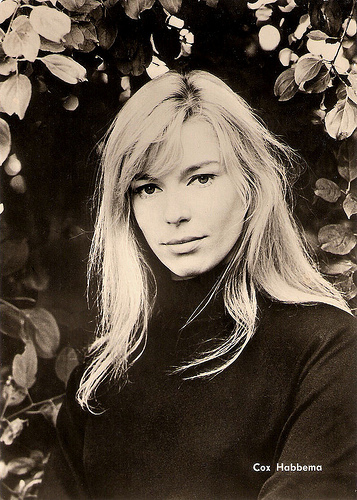
East-German postcard by VEB Progress Film-Vertrieb, Berlin, no. 3307, 1968. Retail price: 0,20 DM. Photo: Reinke/Defa. Publicity still for Wie heiratet man einen König/How to marry a king (1968).
Heart Beat Fresco
Cornelia ‘Cox’ Habbema was born in Amsterdam in 1944. Her brothers are Diederik Habbema and TV and stage director Eddy Habbema. She studied history and for a short while law and then went to the Toneelschool Amsterdam (the Amsterdam Theatre School), where she studied acting and directing.
In 1963, the then 19-year-old Habbema made headlines with a brief affair with the 39-year-old singer Charles Aznavour . Habbema attended his Dutch concerts where she came into contact with Aznavour. He invited her to go with him to his villa on the Riviera, but at Schiphol the military police became suspicious and contacted the family. They commanded the plane, which was on its way to the runway, to return. Cox - at that time still legally a minor - was met by two military policemen on board and handed over to her uncle.
In 1967, Habbema made her stage debut at Toneelgroep Centrum (Theatre Group Centre). Her first film appearance was in the Dutch New Wave production Heart Beat Fresco (Pim de la Parra, 1966), two years later followed by To Grab the Ring (Nikolai van der Heijde, 1968) with Ben Carruthers and Françoise Brion. It was entered into the 18th Berlin International Film Festival.
Meanwhile she was a stage intern of theatre companies in London, Paris, Italy, and Berlin. In Germany she was offered the leading role in the Defa production Wie heiratet man einen König?/How To Marry a King (Rainer Simons, 1968) opposite the German actor Eberhard Esche. He also became her husband.
From 1969 till 1984 she mainly lived and worked in East-Berlin. During this period she was an actress and director for the legendary Deutsches Theater (German Theatre). With Eberhard Esche she also made a series of productions with classical ballads and Heinrich Heine poems. She was both director and singer-performer for these productions.
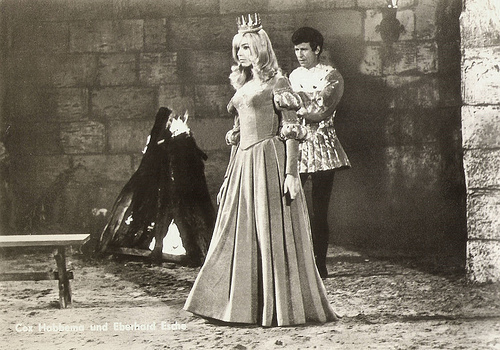
East-German postcard by VEB Progress Film-Vertrieb, Berlin, no. 19/69, 1969. Retail price: 0,20 DM. Photo: Weidt / Defa. Publicity still for Wie heiratet man einen König/How to marry a king (1968) with Eberhard Esche.
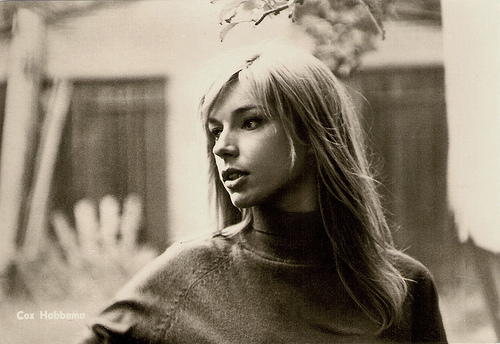
East-German postcard by VEB Progress Film-Vertrieb, Berlin, no. 26/69, 1969. Retail price: 0,20 DM. Photo: Weidt / Defa. Publicity still for Wie heiratet man einen König/How to marry a king (1968).
Revival of the Dutch Cinema
During the 1970s, Cox Habbema played in Dutch and Belgian films and TV series as well as in (East-)German productions. Among her German productions are the crime film Der Mörder sitzt im Wembley-Stadion/The Murder is sitting in Wembley Stadium (Gerhard Respondek, 1970), the Sci-Fi film Eolomea (Herrmann Zschoche, 1972) opposite Bulgarian actor Ivan Andonov, and the medieval adventure tale Till Eulenspiegel (Rainer Simon, 1974).
On TV she appeared in the popular Krimi series Polizeiruf 110/Police Call 110 (1973). She also worked regularly in Belgium, where she played in films like Ieder van ons/Everyone of us (Frans Buyens, 1971) and the TV Series Centraal Station/Central Station (Paul Cammermans, 1974).
In the 1970s there was a revival of the Dutch cinema and Cox Habbema starred in such productions as the thriller Rufus (Samuel Meyering, 1975) between Rijk de Gooyer and John van Dreelen , the drama Kind van de Zon/Child of the sun (René van Nie, 1975), De komst van Joachim Stiller/The Arrival of Joachim Stiller (Harry Kumel, 1976), and Dokter Vlimmen/Doctor Vlimmen (Guido Pieters, 1977).
Henk van Gelder in his necrology for the Dutch newspaper NRC: "At that time, she was known primarily as a 'voyant' blonde with a vamp-like appearance and a subtle ironic tone in the way she, somewhat veiled, expressed her lines."
Habbema appeared opposite husband Eberhard Esche in the Defa productions Leben mit Uwe/Life with Uwe (Lothar Warneke, 1974), Die unverbesserliche Barbara/The Incorrigible Barbara (Lothar Warneke, 1977), also with Hertha Thiele , and the fantasy Der Spiegel des großen Magus/The Mirror of the Great Magus (Dieter Scharfenberg, 1980).
Her best known film is the thriller De stilte rond Christine M./A Question of Silence (Marleen Gorris, 1982). It was highly controversial but also highly acclaimed at the time of its release, and is now hailed as a feminist classic. At IMDb , Adam Fischer reviews the film: “I find this film to be an amazing critique of patriarchy. While murder may not be the solution, this film shows the extraordinary way in which 3 women who have been beaten down their whole lives (and have nothing to lose) attempt to fight back against an enemy that is unbeatable. The laughter at the end of this film proves just who gets it and who doesn't.”
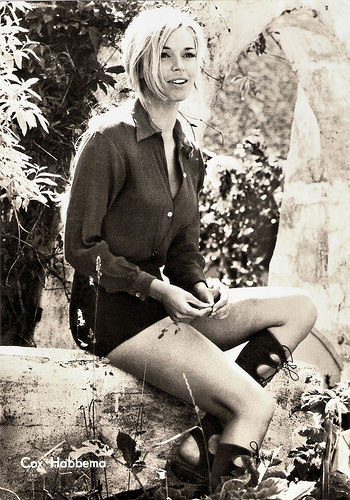
Big East-German card by VEB Progress Film-Vertrieb, Berlin, no. 181/21, 1971. Photo: Defa.
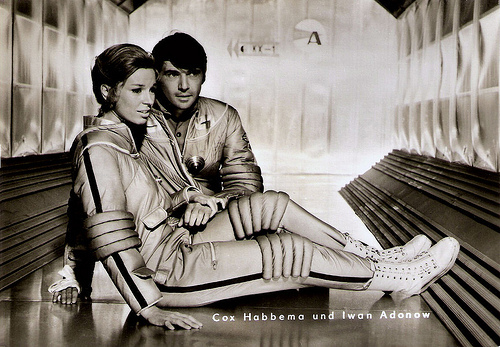
East-German postcard by VEB Progress Film-Vertrieb, Berlin, no. 17/72, 1971. Retail price: 0,20 DM. Photo: Defa. Publicity still for the East German/Soviet/Bulgarian coproduction Eolomea (1971) with Cox Habbema and Ivan Adonov.
Café Cox
In 1984 Cox Habbema returned to the Netherlands. Her film career, both in Germany and in the Netherlands, was over. She worked for the Dutch television as a presenter, producer and editor.
Between 1986 and 1996 she was the director of the Stadsschouwburg Amsterdam (Municipal Theatre Amsterdam). Café Cox, a popular theatre hang-out in the Stadsschouwburg building, was named after her. It was a tumultuous period in which she regularly collided with the stage company Toneelgroep Amsterdam (TGA) about the playing of the theatre.
In 1991 and 1992 Habbema played in the popular Dutch TV series Medisch Centrum West/Medical Centre West. In Germany she had a guest role in an episode of the series Unser Charly/Our Charly (Dieter Kehler, 1998). Other television series in which she appeared were Oog in oog/Eye to Eye (1992), Eindeloos leven/Living Endlessly (1995), and the soap series Het Glazen Huis/The Glass House (2004) starring Willeke van Ammelrooy.
Habbema’s most recent TV appearance was in the drama Kilkenny Cross (Eric Oosthoek, 2006). Since her departure from the Stadsschouwburg, she operated in many managerial functions and as a chairwoman for several Dutch cultural institutes, she lectured at the Tilburg School of Humanities and worked as a trainer and consultant.
In 2002 Habbema published her memoirs, Mijn koffer in Berlijn (My Suitcase in Berlin). In October and November 2004 she went on tour with her monologue Een vrouw in Berlijn (A woman in Berlin), based on a anonymous diary of a young woman in Berlin at the end of the second world war. In 2006 Cox Habbema was honoured for her special merits for the Dutch society and named Officer in the Order of Orange-Nassau.
After her marriage to Eberhard Esche had ended in a divorce, Cox Habbema married lawyer Robert van de Vijver in 1994. He died in 1997.
Trailer for Wie heiratet man einen König?/How To Marry a King (1968). Source: DEFA Stiftung (YouTube).
Trailer for Eolomea (1972). Source: Michael Zschoche (YouTube).
Sources: Henk van Gelder (Nrc.nl - Dutch), Nu.nl (Dutch), Wikipedia (Dutch and German), and .

East-German postcard by VEB Progress Film-Vertrieb, Berlin, no. 3307, 1968. Retail price: 0,20 DM. Photo: Reinke/Defa. Publicity still for Wie heiratet man einen König/How to marry a king (1968).
Heart Beat Fresco
Cornelia ‘Cox’ Habbema was born in Amsterdam in 1944. Her brothers are Diederik Habbema and TV and stage director Eddy Habbema. She studied history and for a short while law and then went to the Toneelschool Amsterdam (the Amsterdam Theatre School), where she studied acting and directing.
In 1963, the then 19-year-old Habbema made headlines with a brief affair with the 39-year-old singer Charles Aznavour . Habbema attended his Dutch concerts where she came into contact with Aznavour. He invited her to go with him to his villa on the Riviera, but at Schiphol the military police became suspicious and contacted the family. They commanded the plane, which was on its way to the runway, to return. Cox - at that time still legally a minor - was met by two military policemen on board and handed over to her uncle.
In 1967, Habbema made her stage debut at Toneelgroep Centrum (Theatre Group Centre). Her first film appearance was in the Dutch New Wave production Heart Beat Fresco (Pim de la Parra, 1966), two years later followed by To Grab the Ring (Nikolai van der Heijde, 1968) with Ben Carruthers and Françoise Brion. It was entered into the 18th Berlin International Film Festival.
Meanwhile she was a stage intern of theatre companies in London, Paris, Italy, and Berlin. In Germany she was offered the leading role in the Defa production Wie heiratet man einen König?/How To Marry a King (Rainer Simons, 1968) opposite the German actor Eberhard Esche. He also became her husband.
From 1969 till 1984 she mainly lived and worked in East-Berlin. During this period she was an actress and director for the legendary Deutsches Theater (German Theatre). With Eberhard Esche she also made a series of productions with classical ballads and Heinrich Heine poems. She was both director and singer-performer for these productions.

East-German postcard by VEB Progress Film-Vertrieb, Berlin, no. 19/69, 1969. Retail price: 0,20 DM. Photo: Weidt / Defa. Publicity still for Wie heiratet man einen König/How to marry a king (1968) with Eberhard Esche.

East-German postcard by VEB Progress Film-Vertrieb, Berlin, no. 26/69, 1969. Retail price: 0,20 DM. Photo: Weidt / Defa. Publicity still for Wie heiratet man einen König/How to marry a king (1968).
Revival of the Dutch Cinema
During the 1970s, Cox Habbema played in Dutch and Belgian films and TV series as well as in (East-)German productions. Among her German productions are the crime film Der Mörder sitzt im Wembley-Stadion/The Murder is sitting in Wembley Stadium (Gerhard Respondek, 1970), the Sci-Fi film Eolomea (Herrmann Zschoche, 1972) opposite Bulgarian actor Ivan Andonov, and the medieval adventure tale Till Eulenspiegel (Rainer Simon, 1974).
On TV she appeared in the popular Krimi series Polizeiruf 110/Police Call 110 (1973). She also worked regularly in Belgium, where she played in films like Ieder van ons/Everyone of us (Frans Buyens, 1971) and the TV Series Centraal Station/Central Station (Paul Cammermans, 1974).
In the 1970s there was a revival of the Dutch cinema and Cox Habbema starred in such productions as the thriller Rufus (Samuel Meyering, 1975) between Rijk de Gooyer and John van Dreelen , the drama Kind van de Zon/Child of the sun (René van Nie, 1975), De komst van Joachim Stiller/The Arrival of Joachim Stiller (Harry Kumel, 1976), and Dokter Vlimmen/Doctor Vlimmen (Guido Pieters, 1977).
Henk van Gelder in his necrology for the Dutch newspaper NRC: "At that time, she was known primarily as a 'voyant' blonde with a vamp-like appearance and a subtle ironic tone in the way she, somewhat veiled, expressed her lines."
Habbema appeared opposite husband Eberhard Esche in the Defa productions Leben mit Uwe/Life with Uwe (Lothar Warneke, 1974), Die unverbesserliche Barbara/The Incorrigible Barbara (Lothar Warneke, 1977), also with Hertha Thiele , and the fantasy Der Spiegel des großen Magus/The Mirror of the Great Magus (Dieter Scharfenberg, 1980).
Her best known film is the thriller De stilte rond Christine M./A Question of Silence (Marleen Gorris, 1982). It was highly controversial but also highly acclaimed at the time of its release, and is now hailed as a feminist classic. At IMDb , Adam Fischer reviews the film: “I find this film to be an amazing critique of patriarchy. While murder may not be the solution, this film shows the extraordinary way in which 3 women who have been beaten down their whole lives (and have nothing to lose) attempt to fight back against an enemy that is unbeatable. The laughter at the end of this film proves just who gets it and who doesn't.”

Big East-German card by VEB Progress Film-Vertrieb, Berlin, no. 181/21, 1971. Photo: Defa.

East-German postcard by VEB Progress Film-Vertrieb, Berlin, no. 17/72, 1971. Retail price: 0,20 DM. Photo: Defa. Publicity still for the East German/Soviet/Bulgarian coproduction Eolomea (1971) with Cox Habbema and Ivan Adonov.
Café Cox
In 1984 Cox Habbema returned to the Netherlands. Her film career, both in Germany and in the Netherlands, was over. She worked for the Dutch television as a presenter, producer and editor.
Between 1986 and 1996 she was the director of the Stadsschouwburg Amsterdam (Municipal Theatre Amsterdam). Café Cox, a popular theatre hang-out in the Stadsschouwburg building, was named after her. It was a tumultuous period in which she regularly collided with the stage company Toneelgroep Amsterdam (TGA) about the playing of the theatre.
In 1991 and 1992 Habbema played in the popular Dutch TV series Medisch Centrum West/Medical Centre West. In Germany she had a guest role in an episode of the series Unser Charly/Our Charly (Dieter Kehler, 1998). Other television series in which she appeared were Oog in oog/Eye to Eye (1992), Eindeloos leven/Living Endlessly (1995), and the soap series Het Glazen Huis/The Glass House (2004) starring Willeke van Ammelrooy.
Habbema’s most recent TV appearance was in the drama Kilkenny Cross (Eric Oosthoek, 2006). Since her departure from the Stadsschouwburg, she operated in many managerial functions and as a chairwoman for several Dutch cultural institutes, she lectured at the Tilburg School of Humanities and worked as a trainer and consultant.
In 2002 Habbema published her memoirs, Mijn koffer in Berlijn (My Suitcase in Berlin). In October and November 2004 she went on tour with her monologue Een vrouw in Berlijn (A woman in Berlin), based on a anonymous diary of a young woman in Berlin at the end of the second world war. In 2006 Cox Habbema was honoured for her special merits for the Dutch society and named Officer in the Order of Orange-Nassau.
After her marriage to Eberhard Esche had ended in a divorce, Cox Habbema married lawyer Robert van de Vijver in 1994. He died in 1997.
Trailer for Wie heiratet man einen König?/How To Marry a King (1968). Source: DEFA Stiftung (YouTube).
Trailer for Eolomea (1972). Source: Michael Zschoche (YouTube).
Sources: Henk van Gelder (Nrc.nl - Dutch), Nu.nl (Dutch), Wikipedia (Dutch and German), and .
Published on April 19, 2016 15:00
April 18, 2016
Camilla von Hollay
Camilla von Hollay (1899–1967) was a Hungarian film actress of the silent era. She appeared in more than 40 films between 1916 and 1930, first in Hungary and later in Germany.
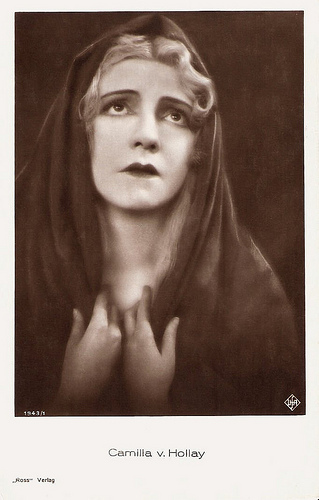
German postcard by Ross Verlag, no. 1943/1, 1927-1928. Photo: Ufa.
Count Dracula
Camilla von Hollay was born as Kamillá Hollai in Budapest, Austria-Hungary (now Hungary).
Her father, the industrialist Adalbert Hollay, wanted her to study medicine after finishing school. Against her parents' will she visited an acting school in 1915. For two years she played in Budapest theatres in plays like Liliom and Pygmalion.
According to German Wikipedia her film debut was already in 1913 in an unknown Hungarian silent film. From 1916 on she started to appear regularly in the cinema billed as Kamilla Hollai. Her second film was Mire megvénülünk/What is Shallow (Ödön Uher jr., 1916).
In the films A régiséggyütjö/The Antiquarian (Alfréd Deésy, 1917), Casanova (Alfréd Deésy, 1918) and the Oscar Wilde adaptation Az élet kiralya/The Picture of Dorian Gray (Alfréd Deésy, 1918), she appeared at the side of Arisztid Olt.
Olt would soon become known as Béla Lugosi and he became a Hollywood icon in his legendary role as Count Dracula.
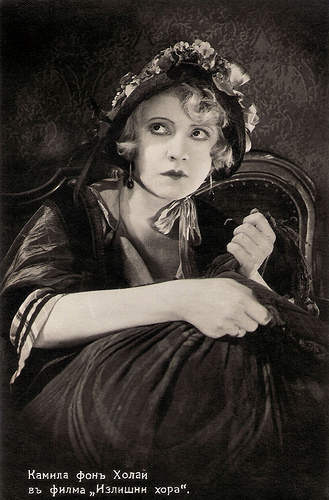
Bulgarian postcard by gr Paskob, Sofia, 1929. Photo: publicity still for Überflüssige Menschen/Superfluous People (Aleksandr Razumnyj, 1926).
Berlin
In 1922, Kamillá Hollai went to Berlin to take over the lead in Das Feuerschiff/The Fire Ship (Richard Löwenbein, 1922). In Germany she changed her name into Camilla von Hollay.
During the 1920s she starred in such German films as Ein Traum vom Glück/A Dream of Happiness (Paul L. Stein, 1924) with Harry Liedtke , Die Wiskottens (Arthur Bergen, 1926), Madame wünscht keine Kinder/Madame Doesn't Want Children (Alexander Korda, 1927), the Asta Nielsen vehicle Gehetzte Frauen/Agitated Women (Richard Oswald, 1927), Die Weber/The Weavers (Friedrich Zelnik, 1927) with Paul Wegener , and Waterloo (Karl Grune, 1928) starring Charles Vanel .
The sound film didn't offer her demanding roles - probably because of her Hungarian accent. She only acted in minor roles in films like Die zärtlichen Verwandten/Beloved Family (Richard Oswald, 1930) and Tingel-Tangel (Jaap Speyer, 1931) featuring Ernö Verebes .
In 1931 she married a journalist and retired. Camilla von Hollay died in Budapest in 1967. She was 67.
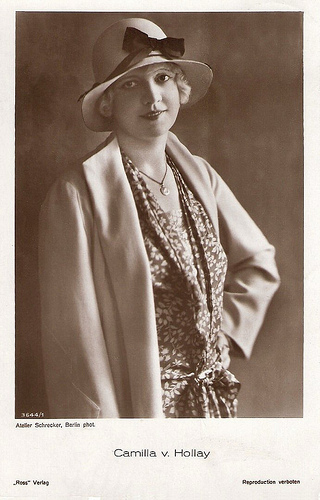
German postcard by Ross Verlag, no. 3644/1, 1928-1929. Photo: Atelier Schrecker, Berlin.
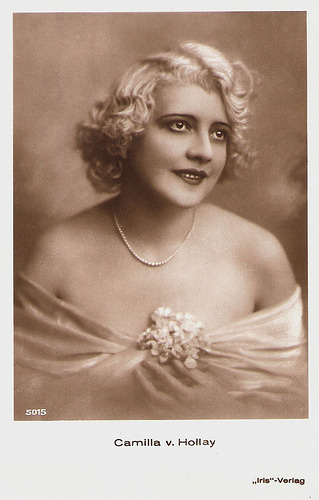
Austrian postcard by Iris-Verlag, no. 5015.
Sources: Thomas Staedeli (Cyranos), Hungarian movie database (Hungarian), Wikipedia (Engels and German), and .

German postcard by Ross Verlag, no. 1943/1, 1927-1928. Photo: Ufa.
Count Dracula
Camilla von Hollay was born as Kamillá Hollai in Budapest, Austria-Hungary (now Hungary).
Her father, the industrialist Adalbert Hollay, wanted her to study medicine after finishing school. Against her parents' will she visited an acting school in 1915. For two years she played in Budapest theatres in plays like Liliom and Pygmalion.
According to German Wikipedia her film debut was already in 1913 in an unknown Hungarian silent film. From 1916 on she started to appear regularly in the cinema billed as Kamilla Hollai. Her second film was Mire megvénülünk/What is Shallow (Ödön Uher jr., 1916).
In the films A régiséggyütjö/The Antiquarian (Alfréd Deésy, 1917), Casanova (Alfréd Deésy, 1918) and the Oscar Wilde adaptation Az élet kiralya/The Picture of Dorian Gray (Alfréd Deésy, 1918), she appeared at the side of Arisztid Olt.
Olt would soon become known as Béla Lugosi and he became a Hollywood icon in his legendary role as Count Dracula.

Bulgarian postcard by gr Paskob, Sofia, 1929. Photo: publicity still for Überflüssige Menschen/Superfluous People (Aleksandr Razumnyj, 1926).
Berlin
In 1922, Kamillá Hollai went to Berlin to take over the lead in Das Feuerschiff/The Fire Ship (Richard Löwenbein, 1922). In Germany she changed her name into Camilla von Hollay.
During the 1920s she starred in such German films as Ein Traum vom Glück/A Dream of Happiness (Paul L. Stein, 1924) with Harry Liedtke , Die Wiskottens (Arthur Bergen, 1926), Madame wünscht keine Kinder/Madame Doesn't Want Children (Alexander Korda, 1927), the Asta Nielsen vehicle Gehetzte Frauen/Agitated Women (Richard Oswald, 1927), Die Weber/The Weavers (Friedrich Zelnik, 1927) with Paul Wegener , and Waterloo (Karl Grune, 1928) starring Charles Vanel .
The sound film didn't offer her demanding roles - probably because of her Hungarian accent. She only acted in minor roles in films like Die zärtlichen Verwandten/Beloved Family (Richard Oswald, 1930) and Tingel-Tangel (Jaap Speyer, 1931) featuring Ernö Verebes .
In 1931 she married a journalist and retired. Camilla von Hollay died in Budapest in 1967. She was 67.

German postcard by Ross Verlag, no. 3644/1, 1928-1929. Photo: Atelier Schrecker, Berlin.

Austrian postcard by Iris-Verlag, no. 5015.
Sources: Thomas Staedeli (Cyranos), Hungarian movie database (Hungarian), Wikipedia (Engels and German), and .
Published on April 18, 2016 22:00
April 17, 2016
Simone Vaudry
Simone Vaudry (1906-1993) was a popular French actress of the silent era and the early sound era. She appeared both in many French and several German films and starred in several popular serials.
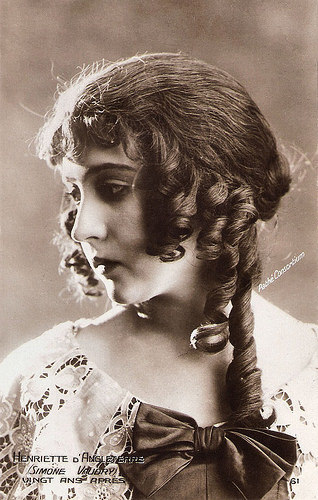
French postcard by Cinémagazine-Édition, Paris, no. 61. Photo: Pathé Consortium. Vaudry as Henriette d'Angleterre in Vingt ans après/Twenty Years After (Henri Diamant-Berger, 1922).
Serial Queen
Simone Vaudry was born Simone Hélène Georgette Vaurigaud in Paris. At the age of four she was already acting in silent films, debuting in the Gaumont production Le crime du grand-père/The crime of the grandfather (Léonce Perret, Jacques Roullet, 1910) written by Abel Gance , in which Suzy Prim co-acted.
In 1913, after various productions at Gaumont by Perret and others, Vaudry started to play in films by Éclair as well, directed by Victorin-Hippolyte Jasset. During the First World War, Vaudry did not act in film, but in 1918 she reappeared in Le Noël d’Yveline/The Christmas of Yveline (Georges-André Lacroix, 1918), Vaudry’s first feature, and again a Gaumont film with Prim.
In the early 1920s followed Les élus de la mer/The Elected of the Sea (Marcel Dumont, Gaston Roudès, 1921) with Gaston Modot , L’épingle rouge/The red pin (Edouard-Emile Violet, 1921), Le double/The Double (Alexandre Ryder, 1921), Mimi Pinson (Théo Bergerat, 1922), the drama Le mouton noir/The Black Sheep (Chalux, 1922), and the fairy tale La belle au bois dormant/Sleeping Beauty (Stéphane Passet, 1922).
In 1922 Vaudry also played Henriette d’Angleterre in the Alexandre Dumas adaptation Vingts ans après/Five Years After (1922) by Henri Diamant-Berger. This serial in ten chapters was the sequel to Diamant-Berger’s adaptation of Les trois mousquetaires/The Three Musketeers (1921).
She also had an important part in the Spanish drama Para toda la vida/For the whole life (Benito Perojo, 1923), in Les Rantzau/The Rantzaus (Gaston Roudès, 1923) starring France Dhélia, La bouquetière des innocents/The Innocent Flower Girl (Jacques Robert, 1923), Les cinquante ans de Don Juan/The Fifty years of Don Juan (Henri Etievant, 1924) starring Charles Vanel , and L’enfant des halles/The Child of Les Halles (René Leprince, 1924) with Suzanne Bianchetti .
In 1924 Vaudry had her first lead in a German film: Das lockende Gefahr/The luring danger (Josef Stein, 1924) and also had small part in the 12 episodes serial Les mystères de Paris/The Mysteries of Paris (Charles Burguet, 1924), starring Huguette Duflos . Vaudry had a much bigger part as Nina in the 8 episodes long Mylord l’Arsouille (René Leprince, 1924), starring Aimé Simon-Girard , and immediately after she had the female lead as Perrette in Fanfan-la-Tulipe (René Leprince, 1925), with again Simon-Girard in the male lead. All these films by Leprince were made for the Société des Cinéromans.
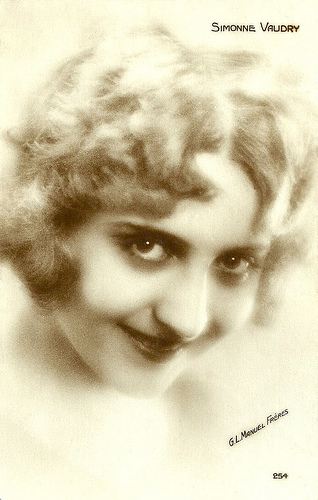
French postcard by G.L. Manuel Frères, Paris, no. 254.
Beatified and Canonized
After a minor part in Les petits/The Little Ones (Marcel Dumont, Gaston Roudès, 1925), Simone Vaudry had the female lead again in La rose effeuillée/The Rose Without Leaves (Georges Pallu, 1925), on the life of Saint Thérèse of Lisieux, who was beatified in 1923 and canonized in 1925. A complete, tinted copy of this previously considered lost film was traced back at the Roman film archive in the mid-1990s, but the film is yet to be represented. In 1936 Pallu would shoot a sound version of the film.
After a small part in another religious film, Le berceau de dieu/The Cradle of God (Fred LeRoy Granville, 1926), Vaudry went to Berlin to play in Die Kreuzzug des Weibes/The Wife's Crusade (Martin Berger, 1926), a film which criticized abortion laws, starring Conrad Veidt and Maly Delschaft .
Vaudry subsequently alternated performances in French films with German productions: Titi, le roi des gosses/Titi, King of the Kids (René Leprince, 1926), La nuit de la revanche/The Night of the Revenge (Henri Etievant, 1926), Pardonnée/Forgiven (Jean Cassagne, 1927), in which Vaudry had the female lead, and Le chasseur de chez Maxim’s/Maxim's Porter (Roger Lion, Nicolas Rimsky, 1927) in France, and Der Herr des Todes/The Master of Death (Hans Steinhoff, 1927), Das Meer/The Sea (Peter Paul Felner, 1927) starring Heinrich George , and Heimweh/Homesick (Gennaro Righelli, 1927) starring Mady Christians in Germany.
In the late silent era Vaudry played the daughter of Francesca Bertini and Warwick Ward in Mein Leben für das Deine/Odette (Luitz-Morat, 1928), based on Victorien Sardou’s melodrama Odette, and had small parts in the operetta film Der fidele Bauer/The Jolly Farmer (Franz Seitz, 1929) with Carmen Boni , and Les Fourchambault/Fourchambault (Georges Monca, 1929) with Charles Vanel .
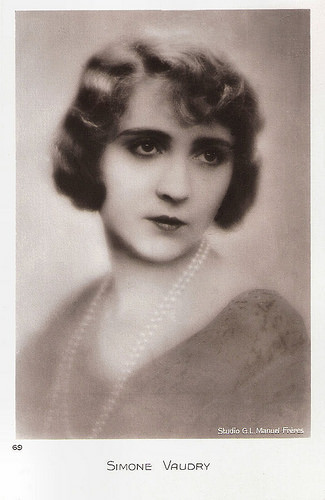
French postcard by Cinémagazine-Édition, Paris, no. 69. Photo: G.L. Manuel Frères, Paris.
Phony Fortune Teller
When sound arrived in France, Simone Vaudry immediately had female leads in La maison des hommes-vivants/The House of the Living Men (Marcel Dumont, Gaston Roudès, 1929), starring Rudolf Klein-Rogge, and Le mystère de la villa rose/The Mystery of the Pink Villa (René Hervil, Louis Mercanton, 1930), starring Léon Mathot . In the latter film she was a phony fortune teller, who witnesses the killing of a rich woman by a band of murderous thieves and is herself suspected of the murder.
After a major part in the comedy Quand te tues-tu?/When Do You Kill Yourself? (Roger Capellani, 1931), shot at the Paris Paramount studios, Vaudry had the female lead in the period piece L’aiglon/The Eagle (Viktor Tourjansky, 1931), starring Jean Weber and based on the famous play by Edmond Rostand.
Next followed the female lead in the Georges Milton comedy Le roi du cirage/The King of Shoe Polish (Pierre Colombier, 1931), the Franco-Italian co-production Les amours de Pergolèse/The Loves of Pergolèse (Guido Brignone, 1932), with Pierre-Richard Willm in the title role and Vaudry in the female lead, Georges Pallu’s film on Saint Bernadette of Lourdes: La vierge du rocher/The virgin of the rock (1933), the Franco-Italian musical comedy Trois hommes en habit/Three men in Dress (Mario Bonnard, 1933), starring singer Tito Schipa, and the comedy Je te confie ma femme/I entrust to you my wife (René Guissart, 1933), starring Arletty .
Vaudry’s last part was in the René Lefèvre comedy Le coup de trois/The blow of three (Jean de Limur, 1936), partly shot in Prague, then Czechoslovachia.
On internet there is no information about what Simone Vaudry did after this film. We only know that she died in Puteaux, France in 1993. She was 86.
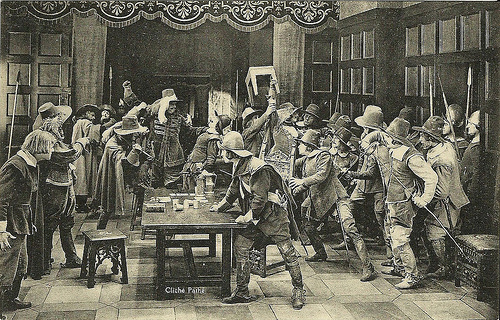
French postcard. Photo: Pathé. Publicity still for Vingt ans après/The Return of the Musketeers (Henri Diamant-Berger, 1922). Collection: Didier Hanson.
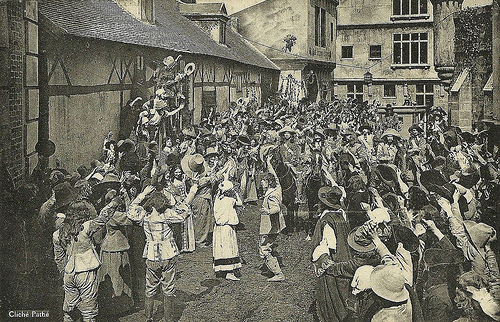
French postcard. Photo: Pathé. Publicity still for Vingt ans après/The Return of the Musketeers (Henri Diamant-Berger, 1922). Collection: Didier Hanson.
Sources: Encyclocine.com, CinéArtistes and .

French postcard by Cinémagazine-Édition, Paris, no. 61. Photo: Pathé Consortium. Vaudry as Henriette d'Angleterre in Vingt ans après/Twenty Years After (Henri Diamant-Berger, 1922).
Serial Queen
Simone Vaudry was born Simone Hélène Georgette Vaurigaud in Paris. At the age of four she was already acting in silent films, debuting in the Gaumont production Le crime du grand-père/The crime of the grandfather (Léonce Perret, Jacques Roullet, 1910) written by Abel Gance , in which Suzy Prim co-acted.
In 1913, after various productions at Gaumont by Perret and others, Vaudry started to play in films by Éclair as well, directed by Victorin-Hippolyte Jasset. During the First World War, Vaudry did not act in film, but in 1918 she reappeared in Le Noël d’Yveline/The Christmas of Yveline (Georges-André Lacroix, 1918), Vaudry’s first feature, and again a Gaumont film with Prim.
In the early 1920s followed Les élus de la mer/The Elected of the Sea (Marcel Dumont, Gaston Roudès, 1921) with Gaston Modot , L’épingle rouge/The red pin (Edouard-Emile Violet, 1921), Le double/The Double (Alexandre Ryder, 1921), Mimi Pinson (Théo Bergerat, 1922), the drama Le mouton noir/The Black Sheep (Chalux, 1922), and the fairy tale La belle au bois dormant/Sleeping Beauty (Stéphane Passet, 1922).
In 1922 Vaudry also played Henriette d’Angleterre in the Alexandre Dumas adaptation Vingts ans après/Five Years After (1922) by Henri Diamant-Berger. This serial in ten chapters was the sequel to Diamant-Berger’s adaptation of Les trois mousquetaires/The Three Musketeers (1921).
She also had an important part in the Spanish drama Para toda la vida/For the whole life (Benito Perojo, 1923), in Les Rantzau/The Rantzaus (Gaston Roudès, 1923) starring France Dhélia, La bouquetière des innocents/The Innocent Flower Girl (Jacques Robert, 1923), Les cinquante ans de Don Juan/The Fifty years of Don Juan (Henri Etievant, 1924) starring Charles Vanel , and L’enfant des halles/The Child of Les Halles (René Leprince, 1924) with Suzanne Bianchetti .
In 1924 Vaudry had her first lead in a German film: Das lockende Gefahr/The luring danger (Josef Stein, 1924) and also had small part in the 12 episodes serial Les mystères de Paris/The Mysteries of Paris (Charles Burguet, 1924), starring Huguette Duflos . Vaudry had a much bigger part as Nina in the 8 episodes long Mylord l’Arsouille (René Leprince, 1924), starring Aimé Simon-Girard , and immediately after she had the female lead as Perrette in Fanfan-la-Tulipe (René Leprince, 1925), with again Simon-Girard in the male lead. All these films by Leprince were made for the Société des Cinéromans.

French postcard by G.L. Manuel Frères, Paris, no. 254.
Beatified and Canonized
After a minor part in Les petits/The Little Ones (Marcel Dumont, Gaston Roudès, 1925), Simone Vaudry had the female lead again in La rose effeuillée/The Rose Without Leaves (Georges Pallu, 1925), on the life of Saint Thérèse of Lisieux, who was beatified in 1923 and canonized in 1925. A complete, tinted copy of this previously considered lost film was traced back at the Roman film archive in the mid-1990s, but the film is yet to be represented. In 1936 Pallu would shoot a sound version of the film.
After a small part in another religious film, Le berceau de dieu/The Cradle of God (Fred LeRoy Granville, 1926), Vaudry went to Berlin to play in Die Kreuzzug des Weibes/The Wife's Crusade (Martin Berger, 1926), a film which criticized abortion laws, starring Conrad Veidt and Maly Delschaft .
Vaudry subsequently alternated performances in French films with German productions: Titi, le roi des gosses/Titi, King of the Kids (René Leprince, 1926), La nuit de la revanche/The Night of the Revenge (Henri Etievant, 1926), Pardonnée/Forgiven (Jean Cassagne, 1927), in which Vaudry had the female lead, and Le chasseur de chez Maxim’s/Maxim's Porter (Roger Lion, Nicolas Rimsky, 1927) in France, and Der Herr des Todes/The Master of Death (Hans Steinhoff, 1927), Das Meer/The Sea (Peter Paul Felner, 1927) starring Heinrich George , and Heimweh/Homesick (Gennaro Righelli, 1927) starring Mady Christians in Germany.
In the late silent era Vaudry played the daughter of Francesca Bertini and Warwick Ward in Mein Leben für das Deine/Odette (Luitz-Morat, 1928), based on Victorien Sardou’s melodrama Odette, and had small parts in the operetta film Der fidele Bauer/The Jolly Farmer (Franz Seitz, 1929) with Carmen Boni , and Les Fourchambault/Fourchambault (Georges Monca, 1929) with Charles Vanel .

French postcard by Cinémagazine-Édition, Paris, no. 69. Photo: G.L. Manuel Frères, Paris.
Phony Fortune Teller
When sound arrived in France, Simone Vaudry immediately had female leads in La maison des hommes-vivants/The House of the Living Men (Marcel Dumont, Gaston Roudès, 1929), starring Rudolf Klein-Rogge, and Le mystère de la villa rose/The Mystery of the Pink Villa (René Hervil, Louis Mercanton, 1930), starring Léon Mathot . In the latter film she was a phony fortune teller, who witnesses the killing of a rich woman by a band of murderous thieves and is herself suspected of the murder.
After a major part in the comedy Quand te tues-tu?/When Do You Kill Yourself? (Roger Capellani, 1931), shot at the Paris Paramount studios, Vaudry had the female lead in the period piece L’aiglon/The Eagle (Viktor Tourjansky, 1931), starring Jean Weber and based on the famous play by Edmond Rostand.
Next followed the female lead in the Georges Milton comedy Le roi du cirage/The King of Shoe Polish (Pierre Colombier, 1931), the Franco-Italian co-production Les amours de Pergolèse/The Loves of Pergolèse (Guido Brignone, 1932), with Pierre-Richard Willm in the title role and Vaudry in the female lead, Georges Pallu’s film on Saint Bernadette of Lourdes: La vierge du rocher/The virgin of the rock (1933), the Franco-Italian musical comedy Trois hommes en habit/Three men in Dress (Mario Bonnard, 1933), starring singer Tito Schipa, and the comedy Je te confie ma femme/I entrust to you my wife (René Guissart, 1933), starring Arletty .
Vaudry’s last part was in the René Lefèvre comedy Le coup de trois/The blow of three (Jean de Limur, 1936), partly shot in Prague, then Czechoslovachia.
On internet there is no information about what Simone Vaudry did after this film. We only know that she died in Puteaux, France in 1993. She was 86.

French postcard. Photo: Pathé. Publicity still for Vingt ans après/The Return of the Musketeers (Henri Diamant-Berger, 1922). Collection: Didier Hanson.

French postcard. Photo: Pathé. Publicity still for Vingt ans après/The Return of the Musketeers (Henri Diamant-Berger, 1922). Collection: Didier Hanson.
Sources: Encyclocine.com, CinéArtistes and .
Published on April 17, 2016 22:00
April 16, 2016
Twelve new acquisitions
Yesterday, we were at the International Collector's Fair in the city of Utrecht. The enormous halls of the Jaarbeurs, full of vintage memorabilia (see the picture below), are the hunting grounds where Bob & Jan hunt for their vintage postcards. In this post six new trophies of Jan and six of Bob.
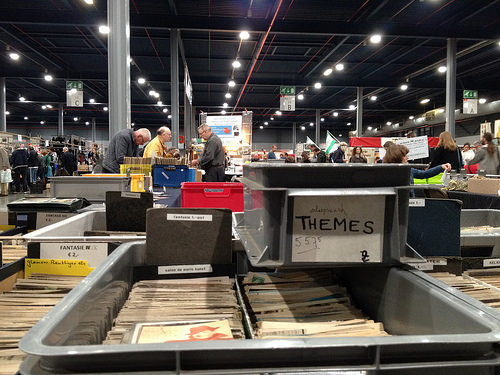
Int. Collector's Fair (Utrecht, April 2016).
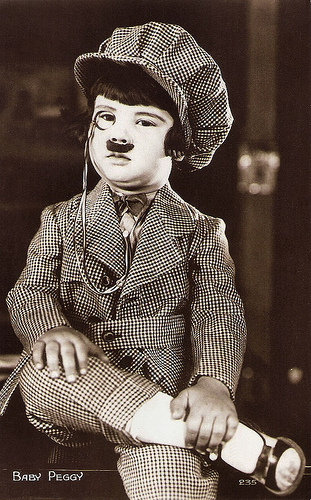
Baby Peggy. French postcard by Cinémagazine-Edition, Paris, no. 235.

French postcard by Croissant, Paris, no. 3672. Photo: Film Pathé. Publicity still for Un drame à Venise/Venetian Tragedy (Lucien Nonguet, 1906). Sent by mail in 1917.

Polaire. French postcard by B.J.C., Paris. Photo: Reutlinger, Paris. Bouffes-Parisiens.
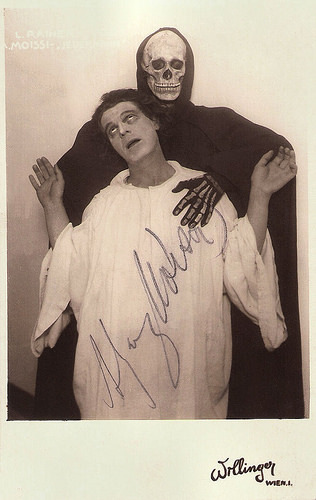
Austrian postcard. Photo: Willinger, Wien. Publicity still for the stage production Jedermann with Alexander Moissi as Jedermann and Luis Rainer as Death, staged at the Salzburger Festspiele 1926.
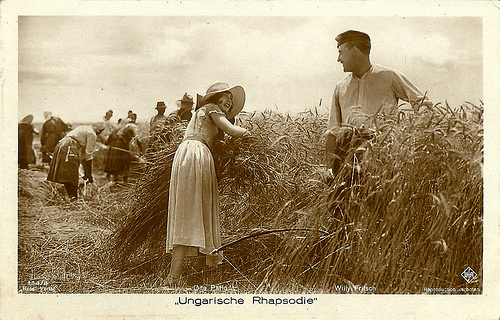
German postcard by Ross Verlag, no. 104/4. Photo: Ufa. Publicity still for Ungarische Rhapsodie/Hungarian Rhapsody (Hanns Schwarz, 1928) with Willy Fritsch and Dita Parlo .
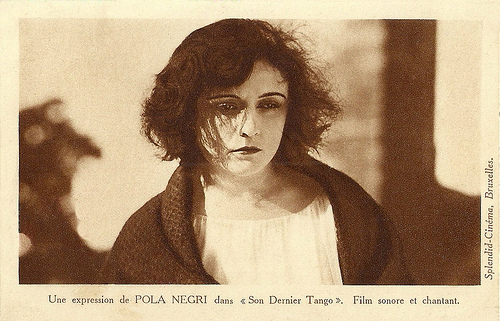
Pola Negri . Belgian postcard issued by the Splendid-Cinéma in Brussels for The Way of Los Souls aka The Woman He Scorned (in French: Son dernier tango, dir. Paul Czinner 1929). It was produced by Gaumont-British as early sound film (some say it was instead a late silent film, so maybe it was shot in both a silent and a sound version). Pola Negri plays a prostitute who marries lighthouse keeper (Hans Rehmann), but her past and her old lover ( Warwick Ward ) haunt her. It was Czinner's first British film. he would eventually settle in Britain with his wife, actress Elisabeth Bergner , pursued by the Nazis. Location shooting was done in Cornwall.
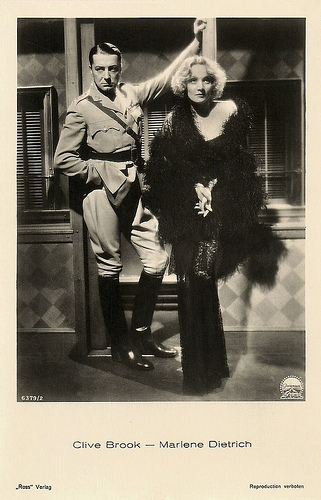
German postcard by Ross Verlag, no. 6379/2, 1931-1932. Photo: Paramount. Marlene Dietrich as Shanghai Lily and Clive Brook as 'Doc' Harvey in Shanghai Express (Josef von Sternberg, 1932).
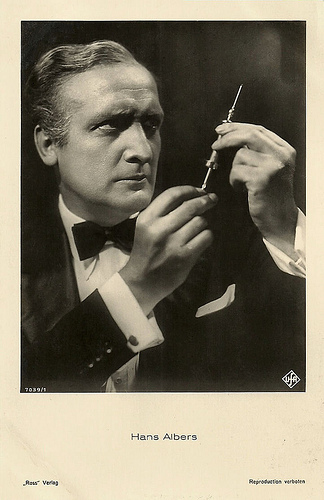
Hans Albers. German postcard. by Ross Verlag, no. 7039/1, 1932-1933. Photo: Ufa. Publicity still for Der weiße Dämon/The White Demon (Kurt Gerron, 1932).
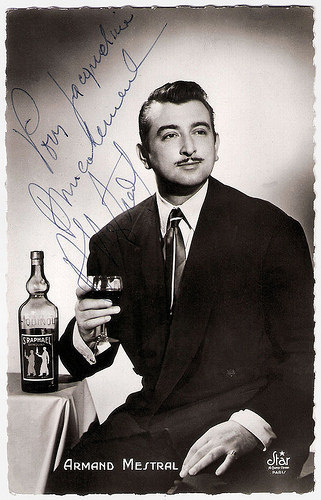
Armand Mestral. French postcard by Studio Star, Paris. Photo: Star, Paris.
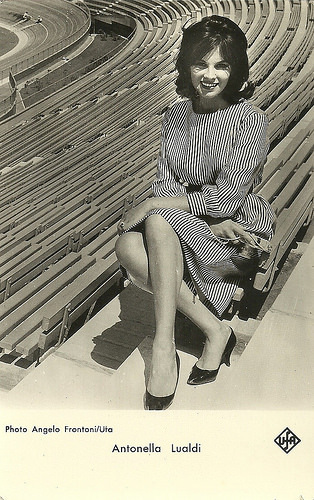
Antonella Lualdi . German postcard by Ufa. Photo: Angelo Frontoni / Ufa.
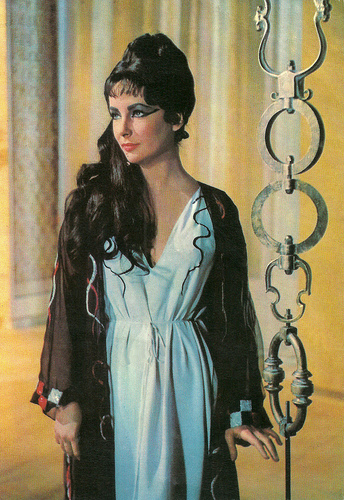
German postcard by ISV, no. A.104. Photo: 20th Century Fox. Elizabeth Taylor in the epic Cleopatra (Joseph Manckiewcz, 1963).
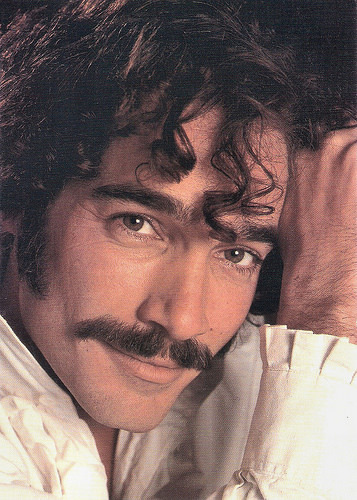
Jean-Marc Barr . British postcard by ABC, London. Photo: publicity still for The Scarlet Tunic (Stuart St. Paul, 1998).

Int. Collector's Fair (Utrecht, April 2016).

Baby Peggy. French postcard by Cinémagazine-Edition, Paris, no. 235.

French postcard by Croissant, Paris, no. 3672. Photo: Film Pathé. Publicity still for Un drame à Venise/Venetian Tragedy (Lucien Nonguet, 1906). Sent by mail in 1917.

Polaire. French postcard by B.J.C., Paris. Photo: Reutlinger, Paris. Bouffes-Parisiens.

Austrian postcard. Photo: Willinger, Wien. Publicity still for the stage production Jedermann with Alexander Moissi as Jedermann and Luis Rainer as Death, staged at the Salzburger Festspiele 1926.

German postcard by Ross Verlag, no. 104/4. Photo: Ufa. Publicity still for Ungarische Rhapsodie/Hungarian Rhapsody (Hanns Schwarz, 1928) with Willy Fritsch and Dita Parlo .

Pola Negri . Belgian postcard issued by the Splendid-Cinéma in Brussels for The Way of Los Souls aka The Woman He Scorned (in French: Son dernier tango, dir. Paul Czinner 1929). It was produced by Gaumont-British as early sound film (some say it was instead a late silent film, so maybe it was shot in both a silent and a sound version). Pola Negri plays a prostitute who marries lighthouse keeper (Hans Rehmann), but her past and her old lover ( Warwick Ward ) haunt her. It was Czinner's first British film. he would eventually settle in Britain with his wife, actress Elisabeth Bergner , pursued by the Nazis. Location shooting was done in Cornwall.

German postcard by Ross Verlag, no. 6379/2, 1931-1932. Photo: Paramount. Marlene Dietrich as Shanghai Lily and Clive Brook as 'Doc' Harvey in Shanghai Express (Josef von Sternberg, 1932).

Hans Albers. German postcard. by Ross Verlag, no. 7039/1, 1932-1933. Photo: Ufa. Publicity still for Der weiße Dämon/The White Demon (Kurt Gerron, 1932).

Armand Mestral. French postcard by Studio Star, Paris. Photo: Star, Paris.

Antonella Lualdi . German postcard by Ufa. Photo: Angelo Frontoni / Ufa.

German postcard by ISV, no. A.104. Photo: 20th Century Fox. Elizabeth Taylor in the epic Cleopatra (Joseph Manckiewcz, 1963).

Jean-Marc Barr . British postcard by ABC, London. Photo: publicity still for The Scarlet Tunic (Stuart St. Paul, 1998).
Published on April 16, 2016 22:00
April 15, 2016
Dany Robin
French actress Dany Robin (1927-1995) was the pert, delicate-looking star in comedies and melodramas of the late 1940s till the late 1960s. The blonde dish with the piled-high hairdo was a one-time threat to the sexy, kittenish Brigitte Bardot.
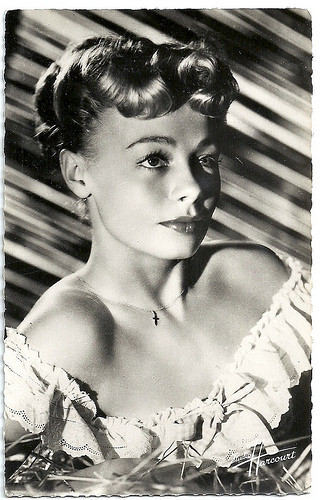
French postcard by Editions du Globe, Paris. Photo: Studio Harcourt.
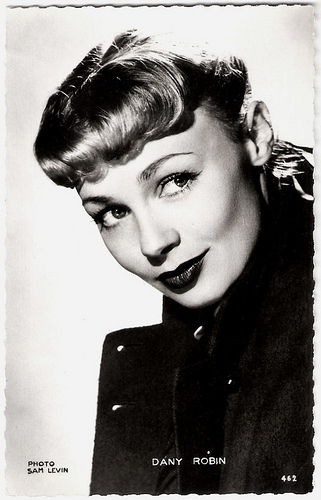
French postcard by Editions P.I., Paris, no. 462. Photo: Sam Lévin.
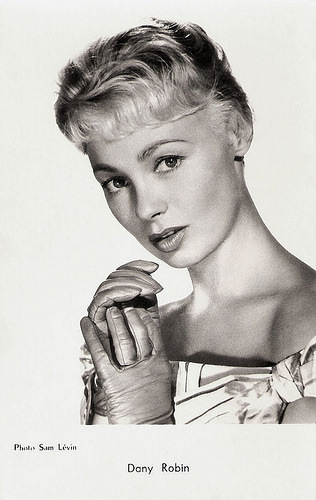
French postcard by Editions P.I., Paris, no. 1117. Photo: Sam Lévin.
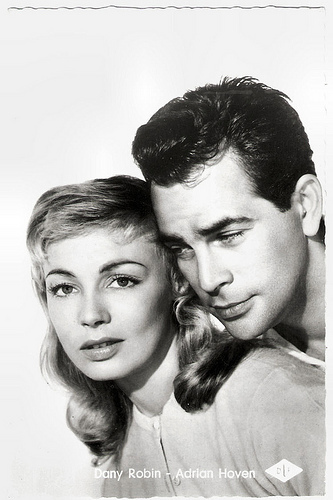
German postcard by Kolibri-Verlag, Minden/Westf, no. 2315. Photo: Melodie / Deutsche London / Heil. Publicity still for Bonsoir Paris/Good Evening Paris (Ralph Baum, 1956).
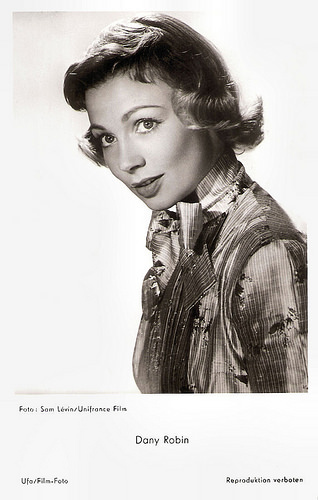
German postcard by Ufa, Berlin-Tempelhof, no. FK 1885. Photo: Sam Lévin / Unifrance Film.
Sensual But Virginal Heroine
Danielle Robin was born in Clamart near Paris, France, in 1927. As a child, Robin trained as a ballerina and eventually made her way to the Opera de Paris under Roland Petit.
At age 19, however, she opted for a film career. Studying at the Conservatoire d'Art Dramatique in Paris, she made her screen debut in the melodrama Lunegarde (Marc Allégret, 1946) with Gaby Morlay.
She worked for such legendary directors as Marcel Carné in Les portes de la nuit/Gates of the Night (1946), and René Clair in Le silence est d'or/Man About Town (1947) opposite French sensation Maurice Chevalier. The latter film was her first real break.
She grew quickly in popularity as a sensual but virginal heroine of light, fluffy comedies as Six heures à perdre/Six Hours to Lose (Alex Joffé, Jean Lévitte, 1946), L'éventail/Naughty Martine (Emil E. Reinert, 1947), and the melodrama Les amoureux sont seuls au monde/Monelle (Henri Decoin, 1948) with Louis Jouvet .
The romance Six heures à perdre also featured the young Louis de Funés , and he and Robin would team up again in the comedies Elle et moi/She and Me (Guy Lefranc, 1952), and Frou-Frou/The Toy Wife (Augusto Genina, 1955).
Other popular films were La fête à Henriette/Henriette (Julien Duvivier, 1952), a Pirandellian comedy about the art of film making, and Les dragueurs/The Chasers (Jean-Pierre Mocky, 1959). Although she was a popular star, journalists awarded her twice (in 1953 and 1954) the Lemon Prize, as the nastiest French actress.
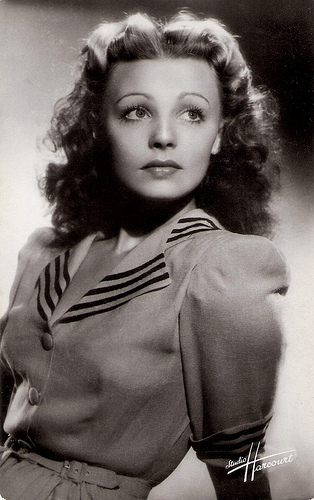
French postcard by Editions O.P., Paris, no. 27. Photo: Studio Harcourt.
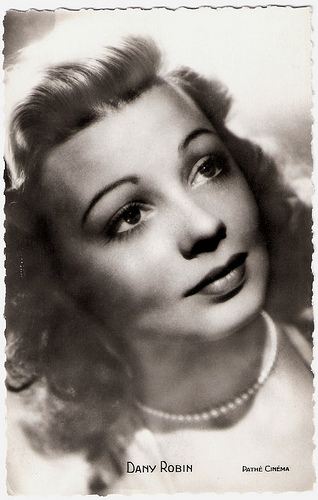
French postcard by Editions P.I., Paris, no. 8. Photo: Pathé Cinema.
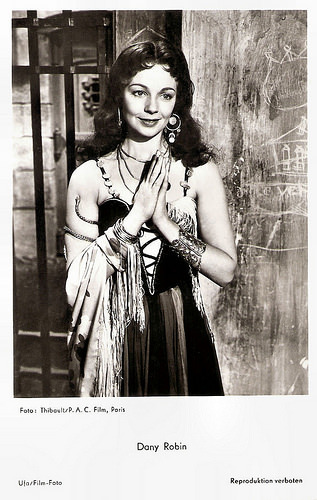
German postcard by Ufa, Berlin-Tempelhof, no. FK 1149. Photo: Thibault / P.A.C.-Film, Paris. Publicity still for Cadet Rousselle (André Hunebelle, 1954).
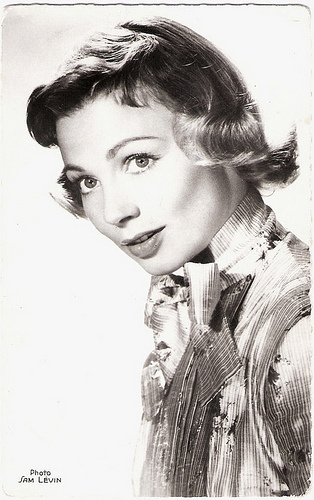
French postcard by Editions du Globe (EDUG), Paris, no. 305. Photo: Sam Lévin.
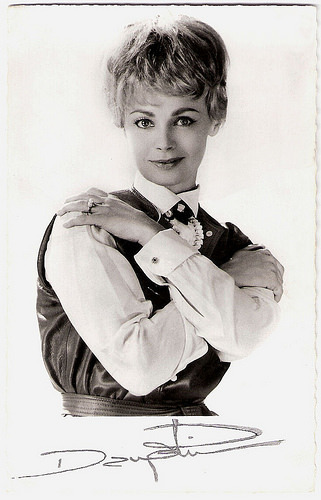
French postcard by Editions P.I., Paris, no. S-1513. Photo: Sam Lévin.
Lithe and Luscious
Though most of her films were produced in France, Dany Robin also worked internationally. The lithe and luscious actress was the female lead opposite Kirk Douglas in the Hollywood production Act of Love (Anatole Litvak, 1953), a bittersweet love story about the star-crossed relationship between a World War II GI and a young Parisian during the Allied liberation of Paris.
She performed with Peter Sellers in the British sex comedy Waltz of the Toreadors (John Guillermin, 1962), and she co-starred with Connie Francis and Paula Prentiss in Follow the Boys (Richard Thorpe, 1963).
In Great Britain she appeared in the thirteenth Carry On film, Don't Lose Your Head (often called Carry On Don't Lose Your Head) (Gerald Thomas, 1966). Set in France and England in 1789 during the French revolution, it is a parody of Baroness Orczy's The Scarlet Pimpernel. Carry on-regular Sid James is the Black Fingernail, a rip-off Scarlet Pimpernel using double entendres and a wide variety of disguises.
Robin’s last leading role was Nicole Devereaux, the wife a French secret agent (Frederick Stafford) in Alfred Hitchcock's thriller Topaz (1969). Dany Robin was married to fellow actor Georges Marchal from 1951 till 1969. They had two children: Frédérique and Robin.
In 1969. she married the Irish producer/agent Michael Sullivan and retired. Both died tragically during a fire in their apartment in Paris in 1995. Dany Robin was 68.
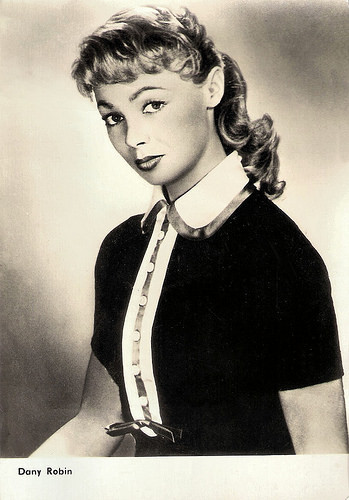
East-German postcard by VEB Progress Filmvertrieb, Berlin, no. 2.302, 1965.
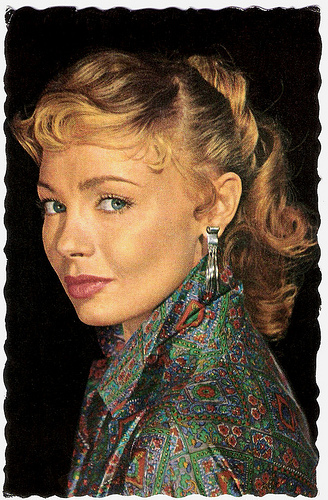
French postcard by Imp. De Marchi Frères, Marseille.
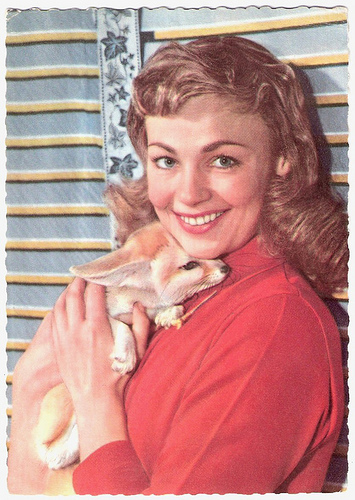
German postcard by Universum-Film Aktiengesellschaft (Ufa), Berlin-Tempelhof, no. CK-53. Retail price: 30 Pfg. Photo: Gérard Décaux / Ufa.
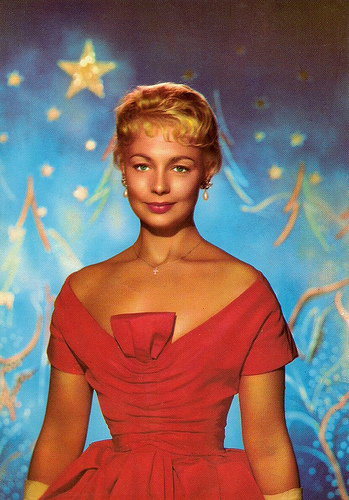
French postcard by Editions P.I., Paris, no. 1004. Photo: Sam Lévin.
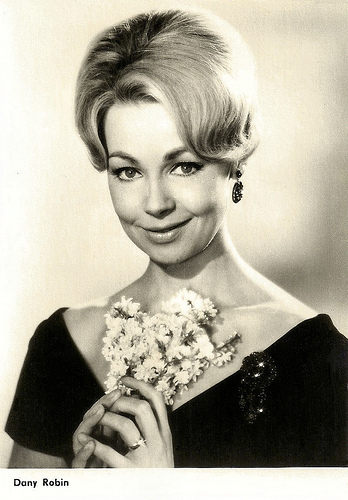
East-German postcard by VEB Progress Filmvertrieb, Berlin, no. 3212. Refers to Robin's Film Liebe an der Seine/ Conduite à gauche (Guy Lefranc, 1961).
Dany Robin, Serge Reggiani and a very young Brigitte Bardot in Act of Love (Anatole Litvak, 1953). Source: Filmographie de Brigitte Bardot (YouTube).
Sources: Hal Erickson (AllMovie), Caroline Hanotte (CinéArtistes – French), (IMDb), Wikipedia, and .

French postcard by Editions du Globe, Paris. Photo: Studio Harcourt.

French postcard by Editions P.I., Paris, no. 462. Photo: Sam Lévin.

French postcard by Editions P.I., Paris, no. 1117. Photo: Sam Lévin.

German postcard by Kolibri-Verlag, Minden/Westf, no. 2315. Photo: Melodie / Deutsche London / Heil. Publicity still for Bonsoir Paris/Good Evening Paris (Ralph Baum, 1956).

German postcard by Ufa, Berlin-Tempelhof, no. FK 1885. Photo: Sam Lévin / Unifrance Film.
Sensual But Virginal Heroine
Danielle Robin was born in Clamart near Paris, France, in 1927. As a child, Robin trained as a ballerina and eventually made her way to the Opera de Paris under Roland Petit.
At age 19, however, she opted for a film career. Studying at the Conservatoire d'Art Dramatique in Paris, she made her screen debut in the melodrama Lunegarde (Marc Allégret, 1946) with Gaby Morlay.
She worked for such legendary directors as Marcel Carné in Les portes de la nuit/Gates of the Night (1946), and René Clair in Le silence est d'or/Man About Town (1947) opposite French sensation Maurice Chevalier. The latter film was her first real break.
She grew quickly in popularity as a sensual but virginal heroine of light, fluffy comedies as Six heures à perdre/Six Hours to Lose (Alex Joffé, Jean Lévitte, 1946), L'éventail/Naughty Martine (Emil E. Reinert, 1947), and the melodrama Les amoureux sont seuls au monde/Monelle (Henri Decoin, 1948) with Louis Jouvet .
The romance Six heures à perdre also featured the young Louis de Funés , and he and Robin would team up again in the comedies Elle et moi/She and Me (Guy Lefranc, 1952), and Frou-Frou/The Toy Wife (Augusto Genina, 1955).
Other popular films were La fête à Henriette/Henriette (Julien Duvivier, 1952), a Pirandellian comedy about the art of film making, and Les dragueurs/The Chasers (Jean-Pierre Mocky, 1959). Although she was a popular star, journalists awarded her twice (in 1953 and 1954) the Lemon Prize, as the nastiest French actress.

French postcard by Editions O.P., Paris, no. 27. Photo: Studio Harcourt.

French postcard by Editions P.I., Paris, no. 8. Photo: Pathé Cinema.

German postcard by Ufa, Berlin-Tempelhof, no. FK 1149. Photo: Thibault / P.A.C.-Film, Paris. Publicity still for Cadet Rousselle (André Hunebelle, 1954).

French postcard by Editions du Globe (EDUG), Paris, no. 305. Photo: Sam Lévin.

French postcard by Editions P.I., Paris, no. S-1513. Photo: Sam Lévin.
Lithe and Luscious
Though most of her films were produced in France, Dany Robin also worked internationally. The lithe and luscious actress was the female lead opposite Kirk Douglas in the Hollywood production Act of Love (Anatole Litvak, 1953), a bittersweet love story about the star-crossed relationship between a World War II GI and a young Parisian during the Allied liberation of Paris.
She performed with Peter Sellers in the British sex comedy Waltz of the Toreadors (John Guillermin, 1962), and she co-starred with Connie Francis and Paula Prentiss in Follow the Boys (Richard Thorpe, 1963).
In Great Britain she appeared in the thirteenth Carry On film, Don't Lose Your Head (often called Carry On Don't Lose Your Head) (Gerald Thomas, 1966). Set in France and England in 1789 during the French revolution, it is a parody of Baroness Orczy's The Scarlet Pimpernel. Carry on-regular Sid James is the Black Fingernail, a rip-off Scarlet Pimpernel using double entendres and a wide variety of disguises.
Robin’s last leading role was Nicole Devereaux, the wife a French secret agent (Frederick Stafford) in Alfred Hitchcock's thriller Topaz (1969). Dany Robin was married to fellow actor Georges Marchal from 1951 till 1969. They had two children: Frédérique and Robin.
In 1969. she married the Irish producer/agent Michael Sullivan and retired. Both died tragically during a fire in their apartment in Paris in 1995. Dany Robin was 68.

East-German postcard by VEB Progress Filmvertrieb, Berlin, no. 2.302, 1965.

French postcard by Imp. De Marchi Frères, Marseille.

German postcard by Universum-Film Aktiengesellschaft (Ufa), Berlin-Tempelhof, no. CK-53. Retail price: 30 Pfg. Photo: Gérard Décaux / Ufa.

French postcard by Editions P.I., Paris, no. 1004. Photo: Sam Lévin.

East-German postcard by VEB Progress Filmvertrieb, Berlin, no. 3212. Refers to Robin's Film Liebe an der Seine/ Conduite à gauche (Guy Lefranc, 1961).
Dany Robin, Serge Reggiani and a very young Brigitte Bardot in Act of Love (Anatole Litvak, 1953). Source: Filmographie de Brigitte Bardot (YouTube).
Sources: Hal Erickson (AllMovie), Caroline Hanotte (CinéArtistes – French), (IMDb), Wikipedia, and .
Published on April 15, 2016 22:00
April 14, 2016
EFSP's Dazzling Dozen: The World of Colette
One of our favourite authors is Sidonie-Gabrielle Colette (1873-1954) or simply Colette. The French novelist, journalist and performer is now best known for her sexy, courageous novels Chéri and Gigi, which were adapted into classic films. But many other films were based on her work; or she wrote dialogues for them. Today 12 dazzling postcards of Colette and of the stars of the films based on her novels.
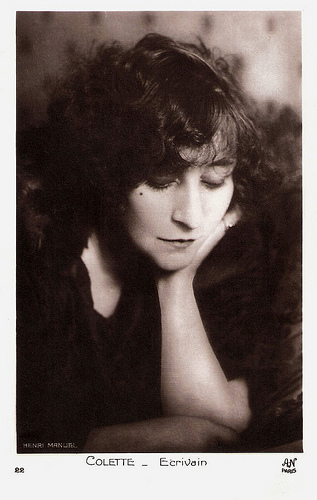
French postcard by A.N. Paris, no. 22. Photo: Henri Manuel.
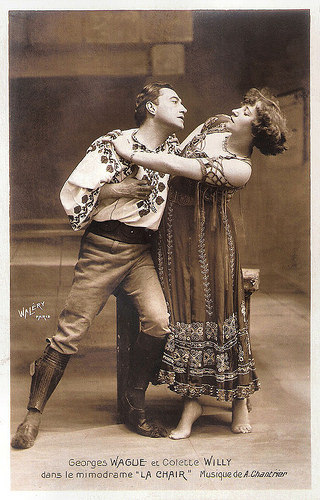
As Colette Willy with Georges Wague in La Chair (1907). French postcard. Photo: Waléry, Paris. Publicity still for the mime drama La Chair/The Flesh (1907) written by Georges Wague and Leon Lambert, with music by Albert Chantrier. It was Colette's greatest stage success.
Claudine
Sidonie-Gabrielle Colette was born in 1873, to war hero and tax collector Jules-Joseph Colette and his wife Adèle Eugénie Sidonie (Sido), nėe Landoy, in the French village of Saint-Sauveur-en-Puisaye. The family was initially well off, but by the time she was of school age poor financial management had substantially reduced her father's income and she attended a public school from the ages of 6 to 17.
In 1893, at age 20, Colette married Henry Gauthier-Villars He was a famous writer, music critic known as 'Willy'. He was 15 years her senior and described as a "literary charlatan and degenerate". He introduced Colette into avant-garde intellectual and artistic circles while engaging in sexual affairs and encouraging her own lesbian dalliances. Her first books, the titillating Claudine series, were published under her husband's pen name Willy.
The Claudine series contained the four novels Claudine à l'école/Claudine at school (1900), Claudine à Paris/Claudine in Paris (1901), Claudine en menage/Claudine Married (1902), and Claudine s'en va/Claudine and Annie (1903). They chart the coming of age of their heroine, Claudine, from an unconventional fifteen year old in a Burgundian village to the literary salons of turn-of-the-century Paris. The story they tell is semi-autobiographical, but not entirely — most strikingly, Claudine, unlike Colette, is motherless. Today, especially Claudine à l'école/Claudine at school (1900) still has the power to charm; in belle époque France it was downright shocking, much to Willy's satisfaction and profit.
Colette and Willy separated in 1906, although it was not until 1910 that the divorce became final. She had no access to the sizable earnings of the Claudine books — the copyright belonged to Willy. Colette went to work in the music halls of Paris, under the wing of Mathilde de Morny, Marquise de Belbeuf, known as 'Missy', with whom she became romantically involved. In 1907, the two performed together in Rêve d'Égypte, a pantomime at the Moulin Rouge. Their onstage kiss nearly caused a riot, which the police were called in to suppress. As a result of this scandal, further performances were banned, and Colette and de Morny were no longer able to live together openly, though their relationship continued for five years.
Until 1912 Colette followed a stage career in music halls across France, sometimes playing Claudine in sketches from her own novels, earning barely enough to survive and often hungry and unwell. This period of her life is recalled in the novel La Vagabonde/The Vagabond (1910), which deals with women's independence in a male society — a theme to which she would regularly return in future works. La Vagabonde received three votes for the prestigious Prix Goncourt.
In 1912, Colette married Henri de Jouvenel, the editor of the newspaper Le Matin. The couple had one daughter, Colette de Jouvenel. Marriage allowed her the time to writing and she devoted herself to journalism. During the war, she converted her husband's Saint-Malo estate into a hospital for the wounded. In 1920, she was made a Chevalier of the Legion of Honour.
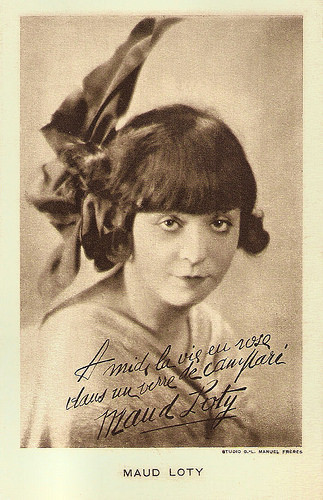
Maud Loty . French postcard. Photo: Studio G.L. Manuel Frères. Caption: "A midi la vie en rose dans un verre de Campari." Maud Loty starred in four silent Claudine films, Claudine à l'école/Claudine at school (1917), Claudine à Paris/Claudine in Paris (1917), Claudine en menage/Claudine Married (1917), and Claudine s'en va/Claudine and Annie (1917). Her co-star was Loulou Hégoburu.
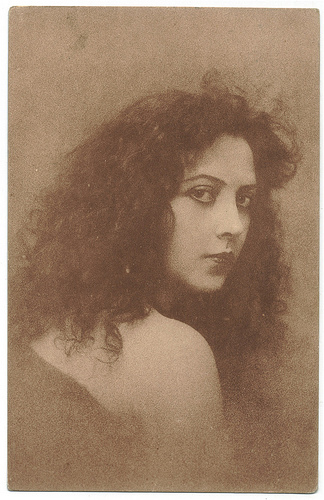
Musidora. French postcard. Photo: G.L. Manuel. Collection: Manuel Palomino Arjona. Musidora was the star of La Vagabonda/The Vagabond (Musidora, Eugenio Perego, 1918), based on Colette's novel La Vagabonde (1910).
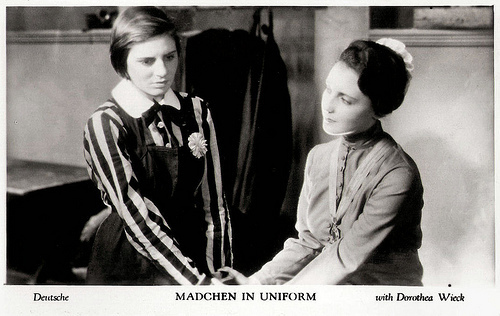
Ellen Schwannecke and Dorothea Wieck in Mädchen in Uniform (1931). British card in the series Film Shots by Film Weekly. Photo: Deutsche. Publicity still for Mädchen in Uniform/Girls in Uniform (Leontine Sagan, Carl Froelich, 1931), for which Colette wrote additional dialogues.
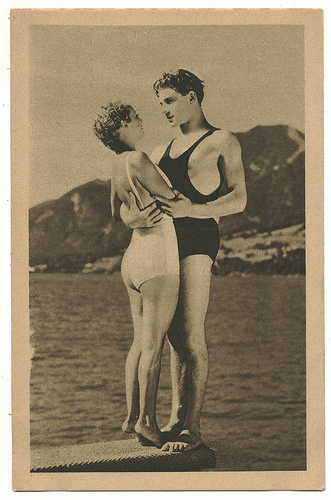
Simone Simon and Jean-Pierre Aumont in Lac aux dames (1934). French postcard. Photo: Belleville-Pathé. Publicity still for Lac aux dames/Ladies Lake (Marc Allégret, 1934), for which Colette wrote the dialogues. Collection: Manuel Palomino Arjona.
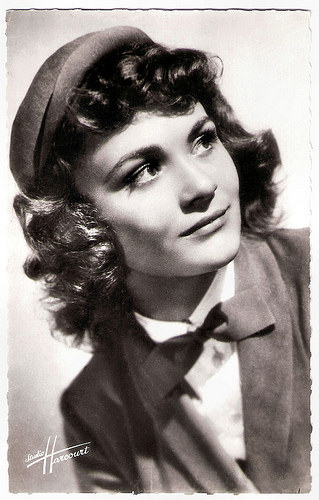
Danièle Delorme . French postcard by Editions du Globe, Paris, no. 108. Photo: Studio Harcourt. Delorme is probably best remembered for her starring roles in the original French production of Gigi (1948) and in Minne (1950), both based on novels by Colette.
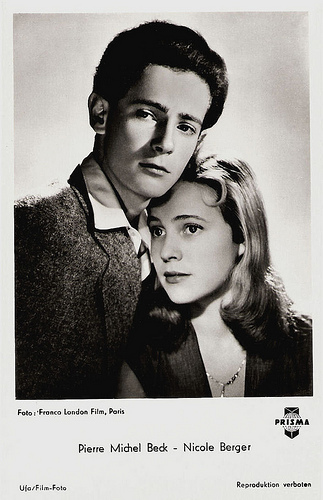
Pierre Michel Beck and Nicole Berger in Le Blé en herbe (1954). German postcard by Ufa, Berlin-Tempelhof, no. FK 1463. Photo: Franco London Film, Paris / Prisma. Publicity still for Le Blé en herbe/The Game of Love (Claude Autant-Lara, 1954).
Chéri and Gigi
Post-World War I, her writing career bloomed following the publication of Chéri (1920). Chéri tells a story of the end of a six-year affair between an ageing retired courtesan, Léa, and a pampered young man, Chéri. Léa is devastated when Chéri marries a girl his own age, and delighted when he returns to her, but after one final night together she sends him away again.
After Chéri, Colette entered the world of modern poetry and painting revolving around Jean Cocteau. She divorced Henri de Jouvenel partly due to Jouvenel's infidelities and partly to Colette's own much talked-about affair with her sixteen year old stepson, Bertrand de Jouvenel. In 1935, Colette married Maurice Goudeket, an uncle of Juliet Goudeket alias Hollywood legend Jetta Goudal . The couple stayed together until her death.
Her novel Le Blé en herbe (1923) dealed again with love between an ageing woman and a very young man, a situation reflecting her relationship with Bertrand de Jouvenel. The decades of the 1920s and 1930s were Colette's most productive and innovative period. Set mostly in Burgundy or Paris during the Belle Époque, her work treated married life, sexuality, and the problems of a woman's struggle for independence.
During the German occupation of France during World War II, her husband Maurice Goudeket, a Jew, was arrested by the Gestapo in December 1941. Although he was released after a few months through the intervention of the French wife of the German ambassador, Colette lived through the rest of the war years with the anxiety of a possible second arrest. She aided her Jewish friends, and hided her husband in her attic.
Her best known work, the novella Gigi (1944), was the basis for several films. It tells the story of sixteen year old Gilberte (Gigi) Alvar. Born into a family of demimondaines, Gigi is being trained as a courtesan to captivate a wealthy lover, but breaks with tradition by marrying him instead. In 1949 Gigi was made into a French film starring Danièle Delorme and Gaby Morlay . In 1951 Gigi was adapted for the stage ny Lerner and Loewe with the then-unknown Audrey Hepburn in the title role, picked by Colette personally. The Hollywood musical Gigi (Vinccente Minelli, 1958), starring Leslie Caron and Louis Jourdan , with a screenplay by Alan Jay Lerner and a score by Lerner and Frederick Loewe, won the Oscar for Best Picture.
In 1948, Colette was nominated for the Nobel Prize in Literature. On her death in 1954, she was refused a religious funeral by the Catholic Church on account of her divorces. Instead she was given a state funeral, the first French woman of letters to be granted this honour, and interred in Père-Lachaise cemetery. She was 81.

Leslie Caron in Gigi (1958). French postcard by Editions du Globe, Paris, no. 662. Photo: Sam Lévin. Publicity still for Gigi (Vincente Minelli, 1958).
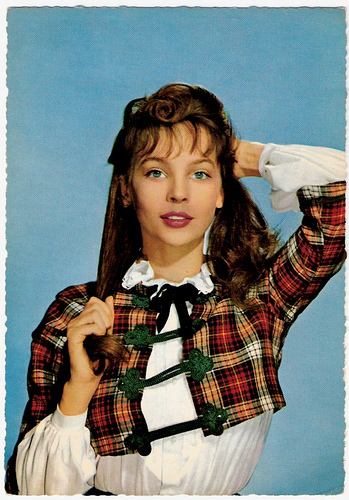
Leslie Caron in Gigi (1958). German postcard by Krüger, no. 902/34. Photo: Sam Levin. Publicity still for Gigi (Vincente Minnelli, 1958).
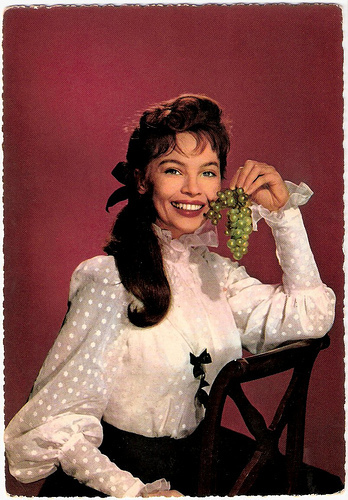
Leslie Caron in Gigi (1958). German postcard by Krüger, no. 902/35. Photo: Sam Lévin. Publicity still for Gigi (Vincente Minnelli, 1958).
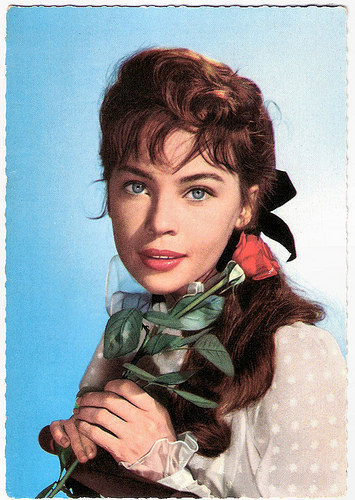
Leslie Caron in Gigi (1958). German postcard by ISV, Amsterdam, no. B 17. Photo: publicity still for Gigi (Vincente Minnelli, 1958).
Sources: Amis de Colette (French), Wikipedia and
This is a post for Postcard Friendship Friday, hosted by Beth at the The Best Hearts are Crunchy. You can visit her by clicking on the button below.


French postcard by A.N. Paris, no. 22. Photo: Henri Manuel.

As Colette Willy with Georges Wague in La Chair (1907). French postcard. Photo: Waléry, Paris. Publicity still for the mime drama La Chair/The Flesh (1907) written by Georges Wague and Leon Lambert, with music by Albert Chantrier. It was Colette's greatest stage success.
Claudine
Sidonie-Gabrielle Colette was born in 1873, to war hero and tax collector Jules-Joseph Colette and his wife Adèle Eugénie Sidonie (Sido), nėe Landoy, in the French village of Saint-Sauveur-en-Puisaye. The family was initially well off, but by the time she was of school age poor financial management had substantially reduced her father's income and she attended a public school from the ages of 6 to 17.
In 1893, at age 20, Colette married Henry Gauthier-Villars He was a famous writer, music critic known as 'Willy'. He was 15 years her senior and described as a "literary charlatan and degenerate". He introduced Colette into avant-garde intellectual and artistic circles while engaging in sexual affairs and encouraging her own lesbian dalliances. Her first books, the titillating Claudine series, were published under her husband's pen name Willy.
The Claudine series contained the four novels Claudine à l'école/Claudine at school (1900), Claudine à Paris/Claudine in Paris (1901), Claudine en menage/Claudine Married (1902), and Claudine s'en va/Claudine and Annie (1903). They chart the coming of age of their heroine, Claudine, from an unconventional fifteen year old in a Burgundian village to the literary salons of turn-of-the-century Paris. The story they tell is semi-autobiographical, but not entirely — most strikingly, Claudine, unlike Colette, is motherless. Today, especially Claudine à l'école/Claudine at school (1900) still has the power to charm; in belle époque France it was downright shocking, much to Willy's satisfaction and profit.
Colette and Willy separated in 1906, although it was not until 1910 that the divorce became final. She had no access to the sizable earnings of the Claudine books — the copyright belonged to Willy. Colette went to work in the music halls of Paris, under the wing of Mathilde de Morny, Marquise de Belbeuf, known as 'Missy', with whom she became romantically involved. In 1907, the two performed together in Rêve d'Égypte, a pantomime at the Moulin Rouge. Their onstage kiss nearly caused a riot, which the police were called in to suppress. As a result of this scandal, further performances were banned, and Colette and de Morny were no longer able to live together openly, though their relationship continued for five years.
Until 1912 Colette followed a stage career in music halls across France, sometimes playing Claudine in sketches from her own novels, earning barely enough to survive and often hungry and unwell. This period of her life is recalled in the novel La Vagabonde/The Vagabond (1910), which deals with women's independence in a male society — a theme to which she would regularly return in future works. La Vagabonde received three votes for the prestigious Prix Goncourt.
In 1912, Colette married Henri de Jouvenel, the editor of the newspaper Le Matin. The couple had one daughter, Colette de Jouvenel. Marriage allowed her the time to writing and she devoted herself to journalism. During the war, she converted her husband's Saint-Malo estate into a hospital for the wounded. In 1920, she was made a Chevalier of the Legion of Honour.

Maud Loty . French postcard. Photo: Studio G.L. Manuel Frères. Caption: "A midi la vie en rose dans un verre de Campari." Maud Loty starred in four silent Claudine films, Claudine à l'école/Claudine at school (1917), Claudine à Paris/Claudine in Paris (1917), Claudine en menage/Claudine Married (1917), and Claudine s'en va/Claudine and Annie (1917). Her co-star was Loulou Hégoburu.

Musidora. French postcard. Photo: G.L. Manuel. Collection: Manuel Palomino Arjona. Musidora was the star of La Vagabonda/The Vagabond (Musidora, Eugenio Perego, 1918), based on Colette's novel La Vagabonde (1910).

Ellen Schwannecke and Dorothea Wieck in Mädchen in Uniform (1931). British card in the series Film Shots by Film Weekly. Photo: Deutsche. Publicity still for Mädchen in Uniform/Girls in Uniform (Leontine Sagan, Carl Froelich, 1931), for which Colette wrote additional dialogues.

Simone Simon and Jean-Pierre Aumont in Lac aux dames (1934). French postcard. Photo: Belleville-Pathé. Publicity still for Lac aux dames/Ladies Lake (Marc Allégret, 1934), for which Colette wrote the dialogues. Collection: Manuel Palomino Arjona.

Danièle Delorme . French postcard by Editions du Globe, Paris, no. 108. Photo: Studio Harcourt. Delorme is probably best remembered for her starring roles in the original French production of Gigi (1948) and in Minne (1950), both based on novels by Colette.

Pierre Michel Beck and Nicole Berger in Le Blé en herbe (1954). German postcard by Ufa, Berlin-Tempelhof, no. FK 1463. Photo: Franco London Film, Paris / Prisma. Publicity still for Le Blé en herbe/The Game of Love (Claude Autant-Lara, 1954).
Chéri and Gigi
Post-World War I, her writing career bloomed following the publication of Chéri (1920). Chéri tells a story of the end of a six-year affair between an ageing retired courtesan, Léa, and a pampered young man, Chéri. Léa is devastated when Chéri marries a girl his own age, and delighted when he returns to her, but after one final night together she sends him away again.
After Chéri, Colette entered the world of modern poetry and painting revolving around Jean Cocteau. She divorced Henri de Jouvenel partly due to Jouvenel's infidelities and partly to Colette's own much talked-about affair with her sixteen year old stepson, Bertrand de Jouvenel. In 1935, Colette married Maurice Goudeket, an uncle of Juliet Goudeket alias Hollywood legend Jetta Goudal . The couple stayed together until her death.
Her novel Le Blé en herbe (1923) dealed again with love between an ageing woman and a very young man, a situation reflecting her relationship with Bertrand de Jouvenel. The decades of the 1920s and 1930s were Colette's most productive and innovative period. Set mostly in Burgundy or Paris during the Belle Époque, her work treated married life, sexuality, and the problems of a woman's struggle for independence.
During the German occupation of France during World War II, her husband Maurice Goudeket, a Jew, was arrested by the Gestapo in December 1941. Although he was released after a few months through the intervention of the French wife of the German ambassador, Colette lived through the rest of the war years with the anxiety of a possible second arrest. She aided her Jewish friends, and hided her husband in her attic.
Her best known work, the novella Gigi (1944), was the basis for several films. It tells the story of sixteen year old Gilberte (Gigi) Alvar. Born into a family of demimondaines, Gigi is being trained as a courtesan to captivate a wealthy lover, but breaks with tradition by marrying him instead. In 1949 Gigi was made into a French film starring Danièle Delorme and Gaby Morlay . In 1951 Gigi was adapted for the stage ny Lerner and Loewe with the then-unknown Audrey Hepburn in the title role, picked by Colette personally. The Hollywood musical Gigi (Vinccente Minelli, 1958), starring Leslie Caron and Louis Jourdan , with a screenplay by Alan Jay Lerner and a score by Lerner and Frederick Loewe, won the Oscar for Best Picture.
In 1948, Colette was nominated for the Nobel Prize in Literature. On her death in 1954, she was refused a religious funeral by the Catholic Church on account of her divorces. Instead she was given a state funeral, the first French woman of letters to be granted this honour, and interred in Père-Lachaise cemetery. She was 81.

Leslie Caron in Gigi (1958). French postcard by Editions du Globe, Paris, no. 662. Photo: Sam Lévin. Publicity still for Gigi (Vincente Minelli, 1958).

Leslie Caron in Gigi (1958). German postcard by Krüger, no. 902/34. Photo: Sam Levin. Publicity still for Gigi (Vincente Minnelli, 1958).

Leslie Caron in Gigi (1958). German postcard by Krüger, no. 902/35. Photo: Sam Lévin. Publicity still for Gigi (Vincente Minnelli, 1958).

Leslie Caron in Gigi (1958). German postcard by ISV, Amsterdam, no. B 17. Photo: publicity still for Gigi (Vincente Minnelli, 1958).
Sources: Amis de Colette (French), Wikipedia and
This is a post for Postcard Friendship Friday, hosted by Beth at the The Best Hearts are Crunchy. You can visit her by clicking on the button below.

Published on April 14, 2016 22:00
April 13, 2016
André van Duin
Funny-looking, reddish André van Duin (1947) is a famous comedian and actor in the Dutch-speaking countries. He is also a singer, writer, and creator of television programs, and he starred in three Dutch film comedies.

Dutch promotion card by CNR, Weesp.
The talent of amusing people
André van Duin was born in Rotterdam, The Netherlands in 1947. His birthname was Adrianus Marinus Kloot, which he legally changed to Adrianus Marinus Kyvon in 1966, a few years after taking the pseudonym André van Duin.
As a kid he developed the talent of amusing people, imitating celebrities and singing. At the age of 15 he sent letters to several TV networks, requesting an audition. In 1964 he was discovered when he won the TV talent contest show Nieuwe Oogst (New Harvest), and started appearing as a guest in a few shows, including that of singing father and daughter Willy Alberti and Willeke Alberti.
In 1965 he got the opportunity to do a television programme of his own, Een avondje TV met André/A TV evening with André. From 1967 onwards, he took apprenticeship at comedians Willy Walden and Piet Muyselaar 's Snip & Snap theatre shows.
In the 1970s André van Duin set up his own Revue with Frans van Dusschoten as the straight man and Corrie van Gorp. These shows were televised on TROS and in 1975 Van Duin won an award for Dag dag heerlijke lach/Hello hello delicious laugh (1974-1975). During this decade Van Duin recorded several hit songs such as Het bananenlied (1972), a parody of The Banana Boat Song.
In 1972, André van Duin began the radio program Dik Voormekaar Show. First with broadcasting company Radio Noordzee Internationaal, later with the NCRV and TROS. He involved his then technician, Ferry de Groot, in the show, becoming the character Meneer de Groot (Mister de Groot). The show continued to air on radio (and for a period also on TV) as recently as 2009.
André van Duin debuted as an actor in the TV series Het meisje met de blauwe hoed/The Girl With The Blue Hat (Dick van 't Sant, 1972), playing an army recruit opposite Jenny Arean. It was a TV version of the film musical Het meisje met den blauwe hoed/The Girl With The Blue Hat (Rudolf Meinert, 1934), with Truus van Aalten and Lou Bandy in the Van Duin part.
In 1976, Van Duin had a massive hit with the song Willempie. Parents of mentally challenged children considered his performance offensive. Van Duin escaped legal actions by apologising on television. Later that year, Van Duin released And're Andre (The Other Andre), an album stripped of wackiness that became the first of five volumes.

Dutch postcard by Postcheque en Girodienst, 's-Gravenhage. Illustration: n.n.
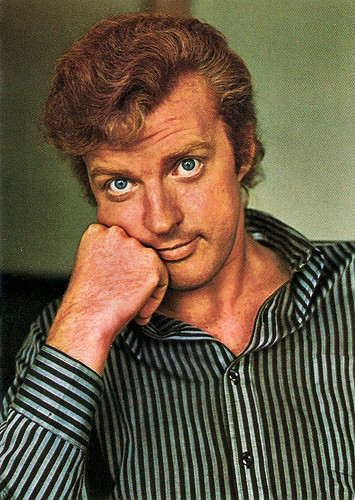
Dutch postcard by Nederlands Artisten Management, Rotterdam.
Both serious and wacky
André van Duin made his film debut with Pretfilm/Fun Film (Robert Kaesen, 1976) in which he played various characters with his croonies from his stage and TV comedies, Frans van Dusschoten and Corrie van Gorp. In 1981 he starred with the same team in another comedy, Ik Ben Joep Meloen/I am Joep Melon (Guus Verstraete, 1981), which was another reasonable success.
In 1982 followed his most ambitious film, De Boezemvriend/The Bosom Buddy (Dimitri Frenkel Frank, 1982), partly an adaptation of the Danny Kaye film The Inspector General (Henry Koster, 1949). Van Duin portrayed charlatan dentist Fred van der Zee who is mistaken for Napoleon's delegate. De Boezemvriend was considered a failure and Van Duin hasn't returned to the big screen since.
Cartoonist Toon van Driel created André's own comic book series in 1987. Very popular was the WWF-promoting TV series Animal Crackers (1988). Van Duin and his new stable-mate Ron Brandsteder were team-captains in the TV show Wie ben ik?/Who am I? (1989), hosted by Caroline Tensen.
Between 1993 and 1999 Van Duin made television shows for RTL. In 2007 the André's Nieuwe Revue-tour was launched; Belgium was visited in November 2008 for five shows in Antwerp. In 2009 he made a new series of Dik Voormekaar Shows. In 2010, Van Duin released the cd Dubbel, made up of both serious and wacky songs.
During his career, André van Duin had 41 singles in the Dutch Top 40, 22 of those reached the Top 10 of which 3 singles became number one. André van Duin was in a relationship with Wim van der Pluym from 1974 until 1995, when Van der Pluym died. Van Duin married Martin Elferink in 2006. In 2013, he returned to TV as Petrus in the hit series 't Schaep met de 5 pooten/The Sheep with five legs. On stage, he impressed with his role in The Sunshine Boys (2015).
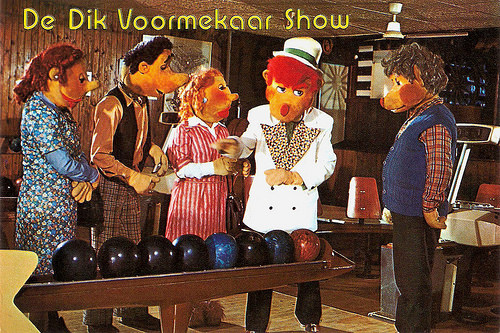
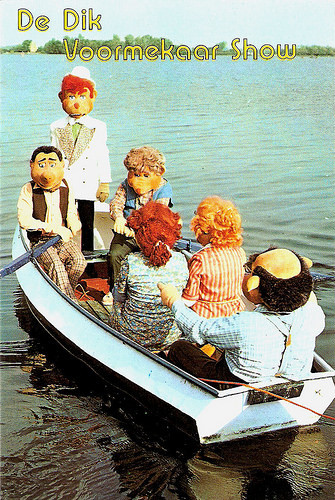
Dutch postcards by Gebr. Spanjersberg, Rotterdam / Antwerpen, 1979. Photos: NAM / Direct Promotion. Publicity stills for the TV series De Dik Voormekaar Show (Guus Verstraete, 1977-1979). TV version of the popular radio program with André van Duin and Ferry de Groot in which the various characters were portrayed on screen by hand puppets in the first season (1977-1978) and full body costumes in the second (1978-1979).
Sources: Wikipedia and .

Dutch promotion card by CNR, Weesp.
The talent of amusing people
André van Duin was born in Rotterdam, The Netherlands in 1947. His birthname was Adrianus Marinus Kloot, which he legally changed to Adrianus Marinus Kyvon in 1966, a few years after taking the pseudonym André van Duin.
As a kid he developed the talent of amusing people, imitating celebrities and singing. At the age of 15 he sent letters to several TV networks, requesting an audition. In 1964 he was discovered when he won the TV talent contest show Nieuwe Oogst (New Harvest), and started appearing as a guest in a few shows, including that of singing father and daughter Willy Alberti and Willeke Alberti.
In 1965 he got the opportunity to do a television programme of his own, Een avondje TV met André/A TV evening with André. From 1967 onwards, he took apprenticeship at comedians Willy Walden and Piet Muyselaar 's Snip & Snap theatre shows.
In the 1970s André van Duin set up his own Revue with Frans van Dusschoten as the straight man and Corrie van Gorp. These shows were televised on TROS and in 1975 Van Duin won an award for Dag dag heerlijke lach/Hello hello delicious laugh (1974-1975). During this decade Van Duin recorded several hit songs such as Het bananenlied (1972), a parody of The Banana Boat Song.
In 1972, André van Duin began the radio program Dik Voormekaar Show. First with broadcasting company Radio Noordzee Internationaal, later with the NCRV and TROS. He involved his then technician, Ferry de Groot, in the show, becoming the character Meneer de Groot (Mister de Groot). The show continued to air on radio (and for a period also on TV) as recently as 2009.
André van Duin debuted as an actor in the TV series Het meisje met de blauwe hoed/The Girl With The Blue Hat (Dick van 't Sant, 1972), playing an army recruit opposite Jenny Arean. It was a TV version of the film musical Het meisje met den blauwe hoed/The Girl With The Blue Hat (Rudolf Meinert, 1934), with Truus van Aalten and Lou Bandy in the Van Duin part.
In 1976, Van Duin had a massive hit with the song Willempie. Parents of mentally challenged children considered his performance offensive. Van Duin escaped legal actions by apologising on television. Later that year, Van Duin released And're Andre (The Other Andre), an album stripped of wackiness that became the first of five volumes.

Dutch postcard by Postcheque en Girodienst, 's-Gravenhage. Illustration: n.n.

Dutch postcard by Nederlands Artisten Management, Rotterdam.
Both serious and wacky
André van Duin made his film debut with Pretfilm/Fun Film (Robert Kaesen, 1976) in which he played various characters with his croonies from his stage and TV comedies, Frans van Dusschoten and Corrie van Gorp. In 1981 he starred with the same team in another comedy, Ik Ben Joep Meloen/I am Joep Melon (Guus Verstraete, 1981), which was another reasonable success.
In 1982 followed his most ambitious film, De Boezemvriend/The Bosom Buddy (Dimitri Frenkel Frank, 1982), partly an adaptation of the Danny Kaye film The Inspector General (Henry Koster, 1949). Van Duin portrayed charlatan dentist Fred van der Zee who is mistaken for Napoleon's delegate. De Boezemvriend was considered a failure and Van Duin hasn't returned to the big screen since.
Cartoonist Toon van Driel created André's own comic book series in 1987. Very popular was the WWF-promoting TV series Animal Crackers (1988). Van Duin and his new stable-mate Ron Brandsteder were team-captains in the TV show Wie ben ik?/Who am I? (1989), hosted by Caroline Tensen.
Between 1993 and 1999 Van Duin made television shows for RTL. In 2007 the André's Nieuwe Revue-tour was launched; Belgium was visited in November 2008 for five shows in Antwerp. In 2009 he made a new series of Dik Voormekaar Shows. In 2010, Van Duin released the cd Dubbel, made up of both serious and wacky songs.
During his career, André van Duin had 41 singles in the Dutch Top 40, 22 of those reached the Top 10 of which 3 singles became number one. André van Duin was in a relationship with Wim van der Pluym from 1974 until 1995, when Van der Pluym died. Van Duin married Martin Elferink in 2006. In 2013, he returned to TV as Petrus in the hit series 't Schaep met de 5 pooten/The Sheep with five legs. On stage, he impressed with his role in The Sunshine Boys (2015).


Dutch postcards by Gebr. Spanjersberg, Rotterdam / Antwerpen, 1979. Photos: NAM / Direct Promotion. Publicity stills for the TV series De Dik Voormekaar Show (Guus Verstraete, 1977-1979). TV version of the popular radio program with André van Duin and Ferry de Groot in which the various characters were portrayed on screen by hand puppets in the first season (1977-1978) and full body costumes in the second (1978-1979).
Sources: Wikipedia and .
Published on April 13, 2016 22:00
Paul van Yperen's Blog
- Paul van Yperen's profile
- 13 followers
Paul van Yperen isn't a Goodreads Author
(yet),
but they
do have a blog,
so here are some recent posts imported from
their feed.



